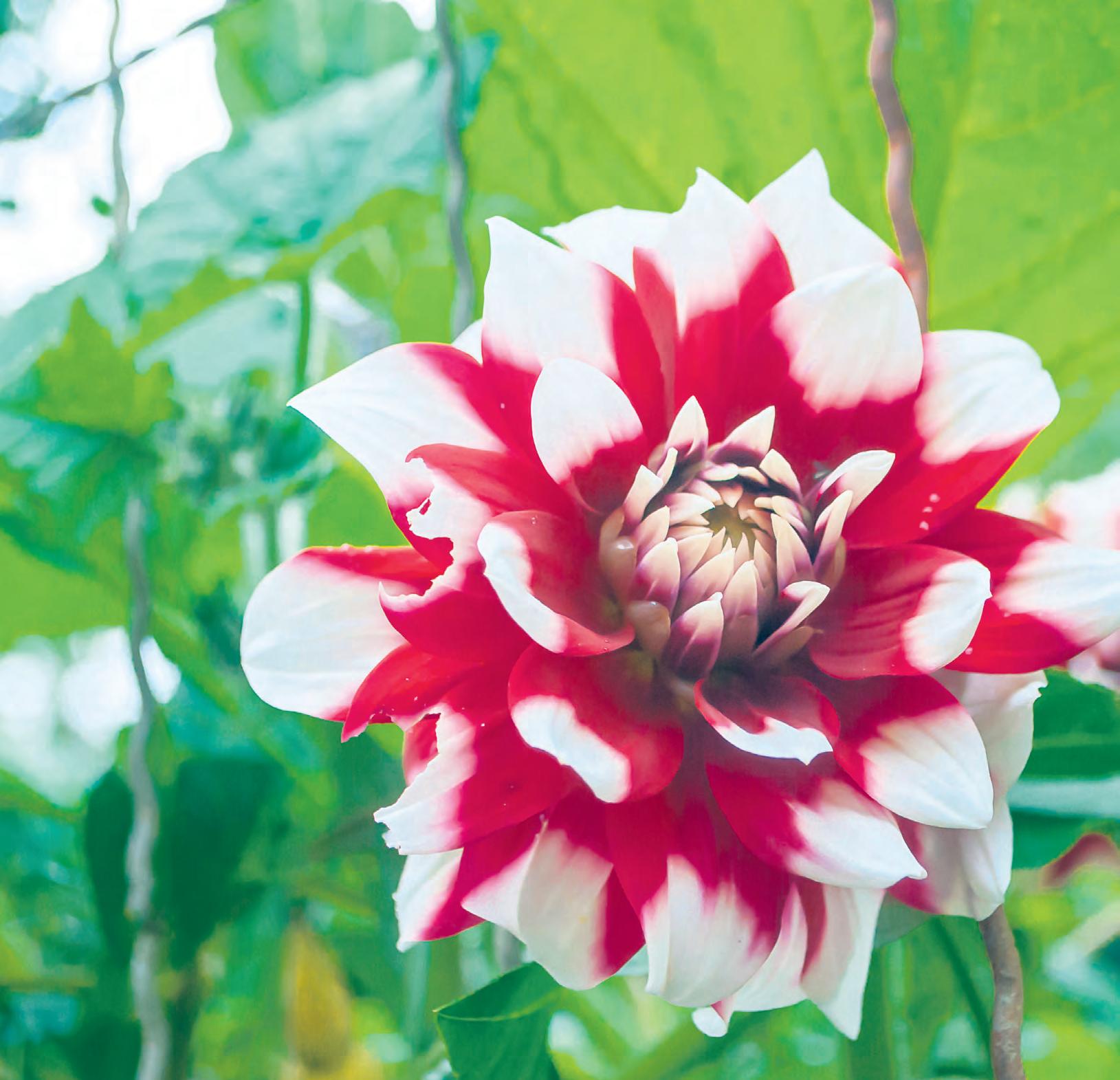








There’s plenty of autumn colour to see in Devon gardens opening for the National Garden Scheme during October, including a new garden to the scheme this year, Ashridge Court at North Tawton.
ASHRIDGE COURT, North Tawton, Devon
EX20 2DH opening for the NGS on Friday 31st October and Saturday 1st November from 11am until 4pm each day, has six acres in the main garden dating from the early 1900s, and a walled garden significantly older. There’s a stunning range of mature conifers, and an Arts and Crafts circular garden room featuring Japanese maples; from Ashridge Great Barn there are steps to a woodland walk via tree ferns.

Admission £6, children free. Homemade teas and light lunches available, and visitors can bring their own picnics. There’s wheelchair access to the top part of the garden and dogs are allowed on short leads.
Ahead of that, DUNLEY HOUSE at Bovey Tracey, Devon TQ13 9PW opens for the NGS on Saturday 18th and Sunday 19th October, 2pm to 5pm both days, a nine-acre garden set among mature oaks, sequoiadendrons and a huge liquidambar, started from a wilderness in the 1980s. Admission £6, children free, homemade teas available, plants for sale, wheelchair access and dogs allowed on short leads.
Also opening for the NGS on the weekend of 18th and 19th October, 2pm to 5pm both days, REGENCY HOUSE at Hemyock, Devon EX15 3RQ is a tranquil five-acre plantsman’s garden approached across a little ford with many interesting and unusual trees and shrubs.

Visitors can try their hand at
identifying plants with the comprehensive plant list.
Admission £8, children free. Homemade teas available, or visitors can bring their own picnics, wheelchair access, dogs allowed on short leads. Visits for the NGS can be arranged with the owners - go to the garden’s entry on the NGS website for more details and this is a venue offering accommodation. www.ngs.org.uk
On Sunday 26th October CHEVITHORNE BARTON, Chevithorne, Tiverton, Devon EX16 7QB is opening for the NGS from 1.30pm until 4.30pm. There are a walled garden, borders and Robinsonian-inspired woodland of rare trees and shrubs with lots of autumn colour, home to National Collection of Quercus (Oaks). Admission £6, children free, with homemade teas available, dogs allowed on short leads and visitors can bring their own picnics, but there is no wheelchair access.

Also on Sunday 26th October, SHERWOOD at Newton St Cyres, Exeter, Devon EX5 5BT opens for the NGS - 23 acres with two steep wooded valleys. Wear suitable footwear due to the areas of steep terrain. There are many berberis and maples to give splendid autumn colours, and a large heather bank. The garden was originally laid out before the First World War, and has been considerably enlarged over the last 40 years, with much care taken to conserve the wildflowers and trees, and to blend the cultivated plants with these to preserve the sense of the natural Devon.
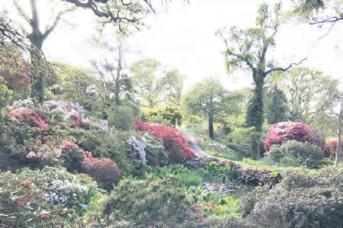
Admission £7.50, children £3, pre-booking essential. Cream teas available. Dogs not allowed. The garden opens by arrangement with the owners for the NGS until 30th December, go to the garden’s entry on the NGS website (above) for more details.
Autumn shows how beautiful it is to let things go
Ross Adams set up Abundant Gardens after reading that if all the gardens in the UK were put together it would cover an area greater than all national nature reserves combined. That means our gardens are filled with potential. His aim from his Totnes base is to see as many gardens supporting as much wildlife as possible.
Now the gardener has a range of services to offer from his Abundant Gardens Consultation ranging from day to day maintenance to more detailed consultation.
There’s around 4,330km² of garden in the UK. They’re an extremely valuable space to encourage biodiversity and connect people to the outdoors – especially as more species disappear from the landscape. The benefits of spending time in the garden are well documented, and with rising costs producing food in our outdoor spaces is increasingly appealing.
Ross has been working with people in their gardens for over 15 years. Over that time, he consistently pinpointed six elements that help bring a garden to life!
Soil – the foundation of a healthy garden
Water – the sustainer of growth and resilience
Wildflowers – the bedrock to supporting wildlife
Planting – the expression of diversity and design
Wild edges – the space where nature leads us
You – the one that helps to bring it all together
The great thing is that these elements are the same regardless of the size of your garden. Not all the elements have to be present but the more that are, the more life is supported.
There’s so much information out there and it’s often conflicting and confusing. Ross’s main aim is to help simplify all this to bring your garden to life! That is why he offers an in-person consultation service to help find clarity and move your garden in the direction you choose, using the six elements as a foundation.
To find out more have a look at abundantgardens.uk or you can find Ross on instagram @abundantgardens_
Get in touch on 07811608359 or at ross@abundantgardens.uk.
Darts Farm Pumpkin Festival 2025 promises to be a vibrant autumnal treat. Held at Darts Farm in Topsham, Devon (EX3 0QH), this much anticipated event will run on selected dates throughout October, from 25th to 31st October, plus earlier weekend slots on 11th to 12th and 18th to 19th October.

Central to the festival is the immense pumpkin patch. With over 12,000 homegrown pumpkins in a variety of shapes, sizes and colours, visitors will have plenty of choice for carving, decorating or simply picking the perfect pumpkin to take home.
Beyond the patch, there are family friendly additions: pumpkin skittles, painting stations, face painting, and intriguingly a ‘guess the weight’ challenge for the giant pumpkin.
Entry is £2.75 per person (under 1s free), not including a pumpkin.
Love the trees until their leaves fall off and then encourage them to try again next year
CHAD SUGG


The most-spotted butterfly in the Devon the three weeks of the Big Butterfly Count was the Gatekeeper.
This summer, 5,709 people took part across the county and spotted 98,303 butterflies and day-flying moths.
While the numbers are a vast improvement the charity has warned urgent measures are still needed to reverse long-term decline.
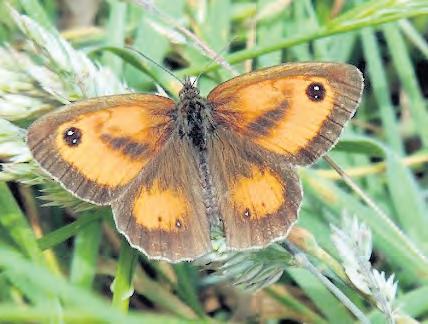
The results show that it was not a bumper summer for beleaguered butterflies.
Between 18th July and 10th August, over 125,000 spotters got involved in Butterfly Conservation’s Big Butterfly Count across the UK – more than ever before – and recorded 1.7 million butterflies and moths, with the top five species being Large White, Small White, Gatekeeper, Red Admiral and Meadow Brown.
The Large White and Small White both recorded their best Big Butterfly Count result. Meanwhile the Small Tortoiseshell, which had its worst result on record in 2024, showed some improvement.
Butterfly Conservation has launched a rescue mission for the UK’s butterflies and is asking the people living in the Cotswolds to sign its open letter to retailers calling for the removal of toxic synthetic pesticides from sale for domestic use. You can add your name by visiting www.butterfly-conservation.org
Big Butterfly Count will return in 2026. Next year’s event will take place between 17th July, and 9th August so be sure to make a note in your diary.
Every autumn, RHS Garden Rosemoor bursts into harvest mode with its Festival of Flavours, returning this year on 4th and 5th October to celebrate the heritage apple crop and the tastes of the season.
Over 35 local traders will line up in the food and craft markets, offering everything from fresh orchard produce to handmade crafts. Highlights include apple variety tasting and pressing demonstrations, and an expert led apple identification service. Culinary inspiration comes courtesy of live cookery demonstrations from Tineke Cooks Cookery School and food writers like Mark Diacono, plus tips on growing and cooking your own produce. For families there’s lots of fun folk music, children’s crafts, tipi activities, even shire horse logging, alongside apple themed fun. Garden admission (free for under 5s, RHS members etc.)
This winter, the Royal Horticultural Society is celebrating the festive season with the return of its spectacular RHS Glow. From 19th November to 4th January, the garden charity will light up its five gardens.
In Devon, RHS Garden Rosemoor, will be lit up on selected dates between 21st November and 30th December.
The updated route will have as a host of sparkling new features and, for the first time, weaves through the redesigned Winter Garden, where trees and light installations create the perfect winter wonderland. Festive shopping and warming seasonal treats at the Garden Restaurant, Otter Cafe, and Shepherd’s Rest takeaway complete the perfect family evening under the stars.

Guided tours are available at the popular Devon coastal garden at Overbeck’s throughout October, offering visitors a unique opportunity to explore this subtropical paradise with the insight of an expert. Nestled on the cliffs above Salcombe, Overbeck’s is known for its rare and exotic plants, vibrant borders, and breathtaking coastal views. During the guided tours, volunteers lead small groups through the garden’s winding paths, sharing stories about the history of the site, the influence of its former owner Otto Overbeck, and the fascinating collection of plants from around the world. October is an especially beautiful time to visit, with autumn colours emerging and late blooms still on display. The tours are ideal for garden enthusiasts, history lovers, or anyone looking to learn more about this hidden gem in Devon. Booking is recommended as spaces are limited, and tour times may vary depending on weather and staff availability. Entry fees apply.
Overbecks, Sharpitor, Salcombe TQ8 8LW
Is there a shared space in your area, or a local planter that could do with a bit of love? Or are you a business whose car park edges are looking a bit bare?
The Big Autumn Sow is back and coming to your rescue! This autumn, Devon Wildlife Trust is giving away free wildflower seed to create mini meadows in community spaces across North Devon. It’s the chance to join with neighbours, colleagues or community to create a wild wildflower patch or get your street buzzing with mini meadows in pots and window boxes. The Big Autumn Sow is part of Devon Wildlife Trust’s Northern Devon Natural Solutions project, supporting to take action for nature.
For free seed contact www.devonwildlifetrust.org

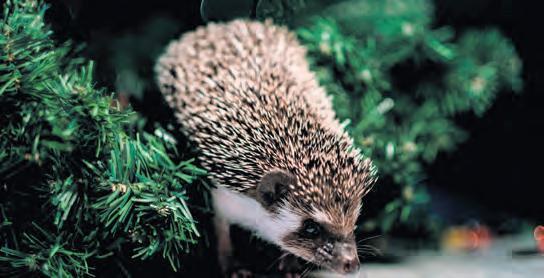
Prices for members start at £8.25 for adults and £4.50 for children. Nonmember prices start from £13.50 for adults and £7.25 for children. Underfives go free. For further pricing information and booking, please visit www.rhs.org.uk/gardens/rosemoor/ whats-on/rosemoor-glow
All RHS Glow tickets must be booked in advance, and visitors are advised to book early to secure their preferred date and time. Ticket prices vary with discounts for RHS members.
The WINTER issue of Country Gardener will be available from Saturday 22nd November Find your nearest stockist www.countrygardener.co.uk/magazine/stockists
The British Hedgehog Preservation Society has issued a three-pointplan to help reduce the risk of harming hedgehogs as the bonfire season approaches.
Fay Vass, chief executive of the society said: “As bonfire season approaches, we’re asking people to help keep the wildlife living in our gardens safe from harm. A bonfire pile looks like a perfect readymade home to a hedgehog seeking a safe winter nest to hibernate in. They have no idea we’re about to set light to it!
The society is asking us all to Stop, Move and Check
1. Stop – do you need to have a bonfire? Can you attend a community event, or mark the occasion in a more wildlife-friendly way? The fewer bonfires there are, the fewer wildlife casualties there will be.
2. Move - if you do decide to have a bonfire, only build it on the day you plan to light it. Move all collected materials to a new site just before burning, in case hedgehogs, other wildlife or pets have decided to hide inside.
3. Check - before lighting from one side only, check the entire bonfire pile carefully for wildlife and pets. Shine a torch inside the pile and gently lift each section with a pole or broom as you look.
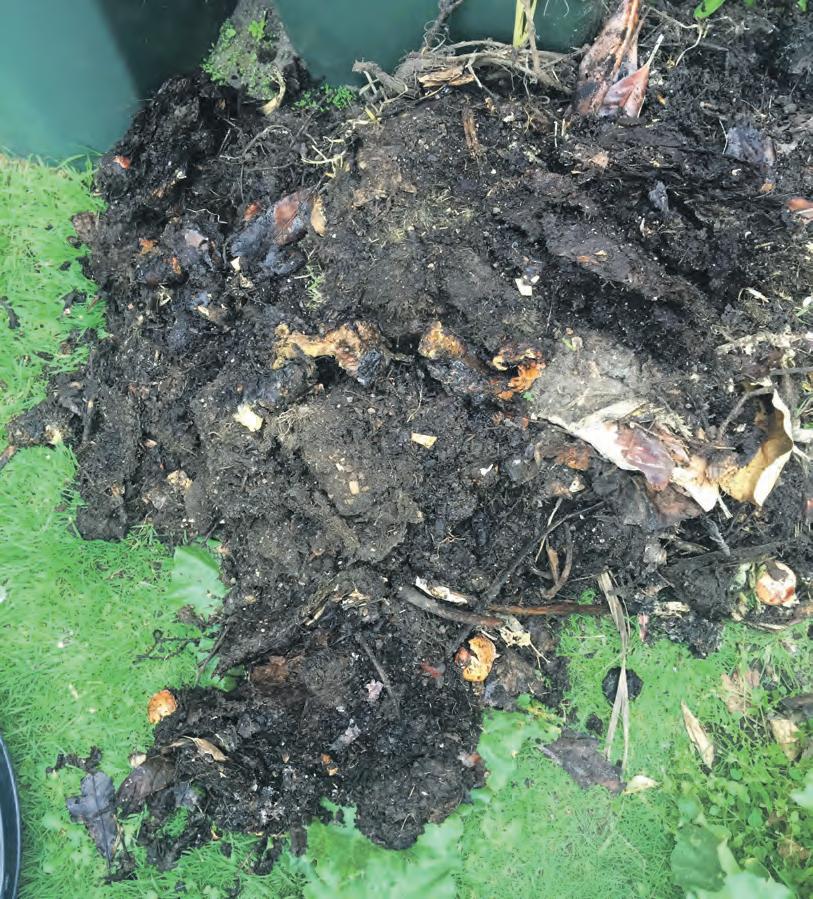

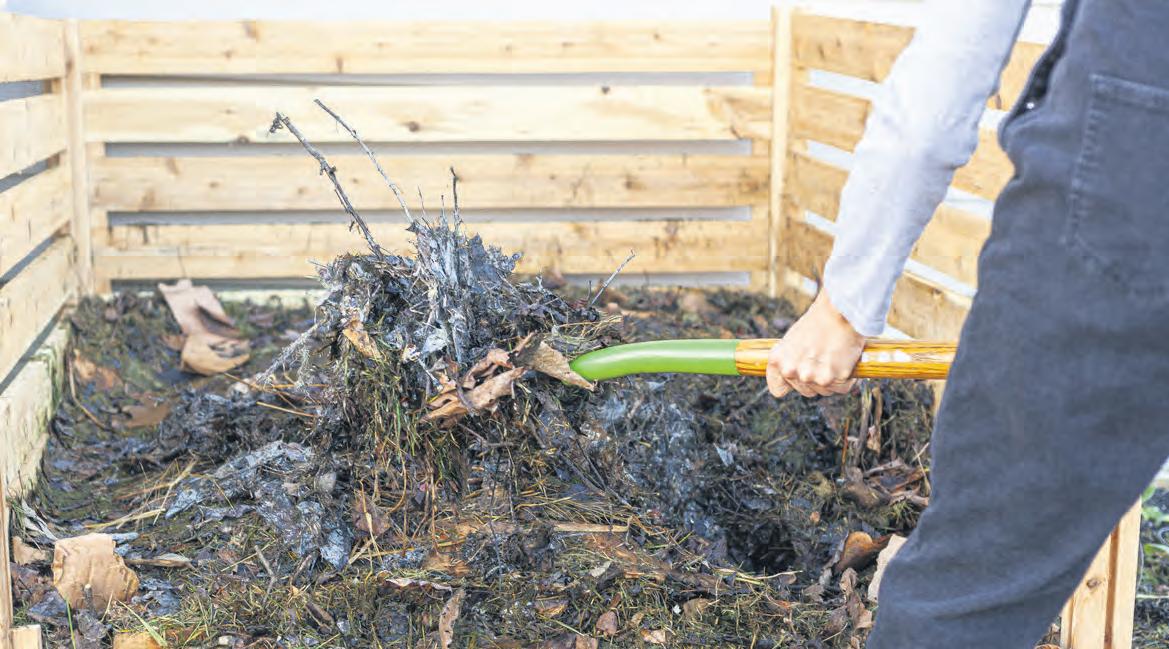
The surge in interest in composting is positive, but too many gardeners seem to be making common mistakes which is either slowing down or destroying the whole process.
While the concept of composting is simple—returning organic material to the earth it can be misunderstood. Errors from gardeners not only slow the decomposition process but can also lead to odour problems, pest infestations, or environmental harm, discouraging lots of would-be composters.
Imbalanced green-to-brown ratio
Perhaps the most common mistake is failing to maintain the proper ratio between ‘greens’ (nitrogenrich materials like food scraps and grass clippings) and ‘browns’ (carbon-rich materials like dried leaves, cardboard, and straw). Many beginners throw kitchen waste into a pile without adding sufficient browns. A balanced ratio (roughly 2:1 browns to greens by volume) is critical for microbial activity. Too much nitrogen leads to wet, smelly compost that may attract pests. Too much carbon slows down decomposition. Composters should keep a ready supply of dry browns (e.g., shredded paper or leaves) and add them regularly. Layering greens and browns or mixing thoroughly helps maintain balance and airflow.
Another frequent error is putting inappropriate items into compost bins. This includes meat, dairy, oily foods, diseased plants, and non-compostable plastics labelled as biodegradable. Meat and dairy attract rodents and can emit foul odours. Some compostable plastics only break down in industrial facilities, not in home systems. Diseased plants can spread pathogens when the compost is applied to soil. Keep to a clear regime of what can and what cannot be added to a compost bin.
Neglecting moisture levels
Both overly dry and overly wet compost piles are problematic. Beginners often ignore moisture levels,
leading to poor decomposition. Microorganisms need moisture to thrive, but not so much that it becomes anaerobic. A soggy pile slows breakdown and produces methane, while a dry pile halts microbial activity altogether. The ideal compost moisture level is like a wrung-out sponge. Add water to dry piles or mix in dry browns to absorb excess moisture. Regular monitoring, especially in extreme weather, is essential. Invest in a basic thermometer to make sure your pile is hot enough. Taking its temperature is a great indicator of whether or not you need to add water or not.
Poor aeration and turning
Compost piles are often left unturned or compacted, reducing oxygen levels. Without oxygen, the pile becomes anaerobic, emitting methane and producing a foul odour. Turning the compost introduces oxygen, accelerates decomposition, and helps control temperature. For hot composting, turn the pile every few days or at least once a week. For cold composting, less frequent turning is acceptable but still beneficial. Avoid over-compacting the pile by keeping bulky browns in the mix. Remember to get as much air into the compost bin as possible. Regular turning of the pile is the most efficient way to achieve this.
Composting in inappropriate containers or wrong locations
Using non-ventilated bins, placing compost piles in full sun (or deep shade), or setting them directly on nondraining surfaces like concrete are common location mistakes. Location affects temperature, drainage, and accessibility. Bins without airflow trap gases and heat unevenly. Poorly placed piles may leach into water sources or become inaccessible during winter. Use bins with ventilation, elevate or place them on soil for drainage, and choose a semi-shaded area protected from extreme weather. Accessibility also matters: people are more likely to compost if the system is easy to reach. Expecting instant results
Many people expect compost to be ready in a few weeks and give up when it doesn’t happen. Composting is a natural process that can take up to six months
or more depending on the method, materials, and environmental conditions. Unrealistic expectations can deter some people from starting the composting processes. Composters need to be realistic and patient on timelines and stages of decomposition. It’s so much better to be watchful with patience, and use multiple bins to allow staggered use.
Ignoring local regulations or resources
In some areas, composting is regulated due to pest concerns or environmental issues. Many people either ignore these regulations or remain unaware of valuable local composting services. Improper composting can cause community tensions or fines. Additionally, some areas offer free pickup, training, or community composting hubs that go underused. Encourage residents to connect with local waste management authorities or environmental groups. Promote community composting programs where feasible, especially in apartment buildings or urban areas.
Governments, schools, and community leaders must work together to provide tools, training, and infrastructure.
On a larger scale, councils are now starting to really invest in successful composting programmes, composting facilities, and incentives for businesses to participate. Widespread use of waste material into compost which is then recycled and offered back to the community has grown by over 200 per-cent in the last seven years.
Schools are incorporating composting into science and sustainability curricula.
The convergence of environmental crises, waste challenges, and growing ecological consciousness makes now the peak time for composting. It is a practice deeply rooted in nature, yet modernized by new technologies, policies, and community efforts.

Wildlife Habitat & Edible Garden Specialists
Maintenance - Consultation Scything Courses - Nature Connection
www.abundantgardens.uk
Tel: 07811 608359 Email: ross@abundantgardens.uk

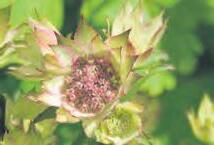
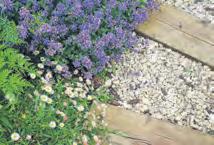

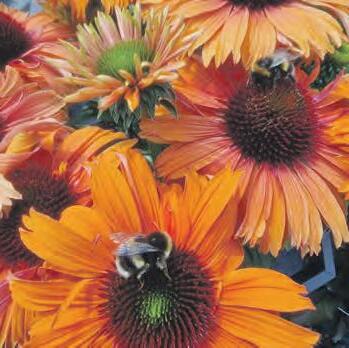
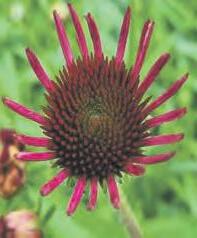

Fine Turf (Devon) Ltd, a family run business established in 1966, supply a locally seeded turf, suitable for a variety of gardens, which has been treated and fertilised several times throughout the growing period.
Elevate Your Home with Sustainable Garden Design
Create a space that restores and inspires. Therapeutic, wildlifeenhancing gardens designed with harmony, structure, and seasonal beauty. Grounded in nature, rooted in well-being.
We also supply topsoil, composts and landscaping bark for all your gardening needs, we can mix these for your requirements for planting flowerbeds and vegetable plots. All our topsoil is certified and stored dry all year round, as are the composts.
www.rosemarytree.co.uk rosie@rosemarytree.co.uk
Spring Flowering
Bulbs Available for Planting Now!
Selection of Trees, Shrubs, Fruit, Roses, Perennials, Alpines, Seeds & more... Help Advice & Friendly Service
Check our website for details or find us on Facebook!
www.covegardennursery.co.uk Tel: 01398 331946


WE SUPPLY LOCALLY SEEDED TURF, TOPSOIL, COMPOSTS (MUSHROOM/ORGANIC GREEN WASTE) AND LANDSCAPING BARK, WHICH WE CAN DELIVER OR YOU ARE WELCOME TO COLLECT.
652538 Lower Waye Farm, Ashburton TQ13 7ET

Lower Waye Farm, Ashburton TQ13 7ET TEL: 01364 652538
On the A396, Cove, Tiverton EX16 7RU



EMAIL: fineturfdevon@gmail.com WEBSITE: turfdevon.co.uk



Care home residents and the local community enjoyed a day of animals and entertainment at Kenwith Castle care home’s summer fayre.
The Abbotsham-based care home welcomed residents’ families and visitors to join their special event which took place in the lounge and garden area.
The event featured donkeys from Highford Donkeys, alpacas from Star Acre Farm, and a fun dog show from Pets as Therapy for the residents, their families and visitors to enjoy. Vintage cars parked outside the home were open for residents to sit in and reminisce about vehicles owned over the years, and there was a range of stalls from the local community selling gifts, clothes, cakes and crafts. Jo Passmore, Home Manager at Kenwith Castle, said: “We were so pleased to welcome so many members of the local community who came to support our summer fayre. There was such a wonderful, happy atmosphere throughout the day, with residents thrilled to see the donkeys and alpacas for some ‘fur therapy.’ At Care South, we love enabling our residents to continue to be part of their local community, whether that involves hosting events in our home, or organising trips out in our minibus to visit their favourite places.”
Kenwith Castle care home, which is part of the not-forprofit charity, Care South, provides residential, respite, and dementia care to residents. A dedicated activities team at the care home organises a daily programme of events to bring residents together to socialise and build friendships,
which can include crafts, gardening, live entertainment, games, and baking.
The home benefits from a large garden and expansive landscaped grounds featuring a picturesque lake with stunning countryside views offering a quiet place for a moment of reflection.
Featuring wide, flat walkways and raised flower beds, the garden has been designed to make it accessible to everyone. It is also the perfect setting for residents to enjoy a host of community events, garden parties and barbecues to make the most of the sunnier weather, with friends and families always encouraged to join in the fun.
The grounds are also home to assisted-living bungalows, Kenwith Castle Gardens and Kenwith Meadows, as well as The Pavilion, which offers a meeting place for residents to get together for a range of events.
The Kenwith Castle care home team host their own ‘Welcome Wednesdays’ session every week from 2pm to 4pm for visitors to enjoy the warm and friendly atmosphere over coffee and cake. There is no need to book - just drop in on the day.
For more information about the care services at Kenwith Castle, visit care-south.co.uk or call 01237 879594 to book a tour.




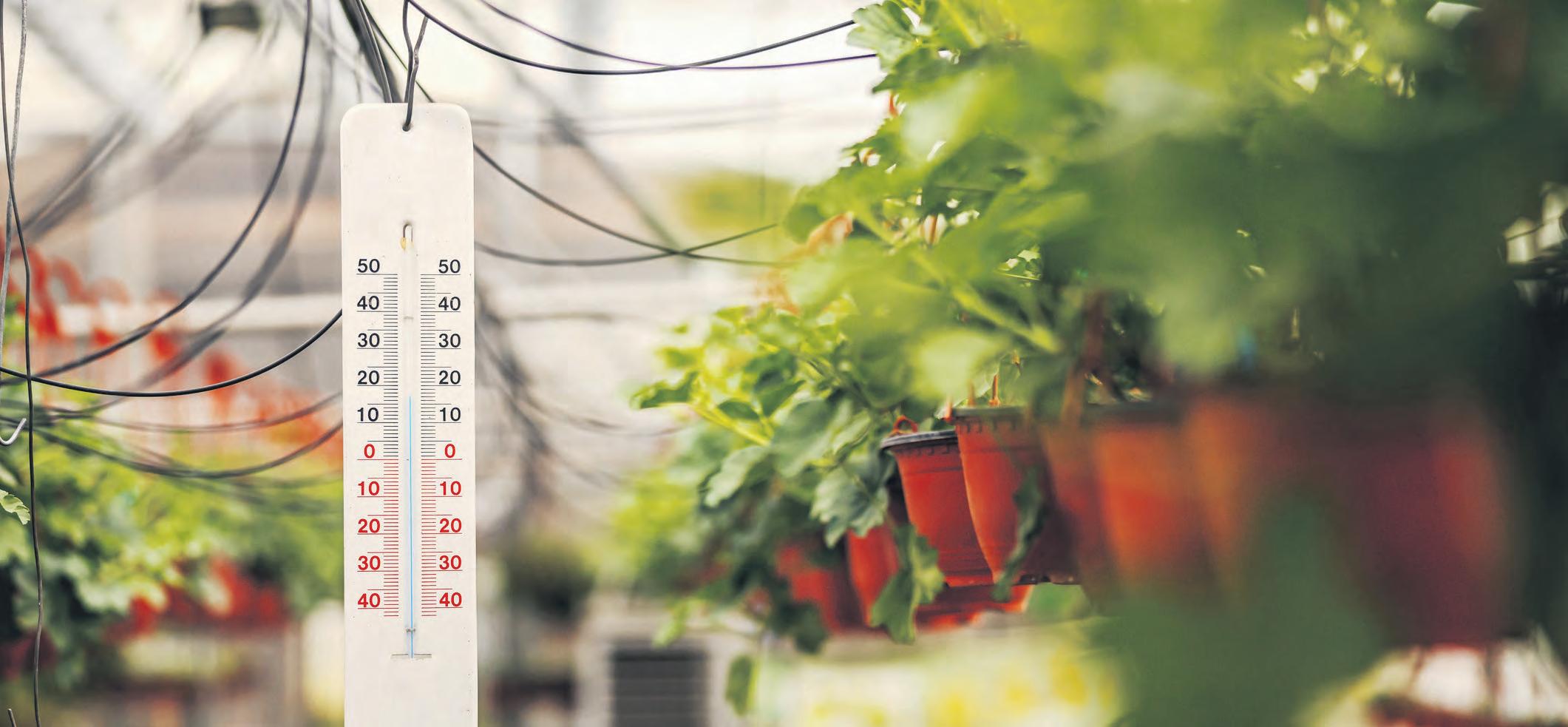
Heating a greenhouse in winter can transform it into a productive, thriving space, even during the coldest months. For many growers, particularly those cultivating tender crops or aiming for yearround production, winter heating is not just beneficial—it’s essential. It can be a problematical decision either way.
• Protecting delicate plants
• Extended growing seasons
• Higher yields and faster growth
• Better seed starting
• Plant health and disease prevention
• Climate control for specialty plants
If you’re growing tropical or warm-season plants like tomatoes, peppers, orchids, or citrus, these cannot survive cold snaps. Even a single frost can kill or severely damage them. A heated greenhouse provides a stable environment, ensuring that sensitive plants remain healthy and productive.
Heating allows you to extend your growing season—or skip the downtime entirely. With a warm environment, crops like lettuce, spinach, and herbs can be grown continuously. This is especially useful for market gardeners or anyone trying to reduce grocery costs by growing their own food year-round.
Most plants slow down or go dormant in cold conditions. Warmer temperatures encourage faster germination and vigorous growth. Heating supports a more consistent, predictable growth cycle, helping you plan harvests better and get more from each square foot of greenhouse space.
Fluctuating temperatures and humidity levels in an unheated greenhouse can lead to issues like mould, mildew, and damping-off disease in seedlings. A controlled heated environment keeps conditions optimal, reducing plant stress and improving overall health.
Heated greenhouses are ideal for starting seeds earlier in the year. Rather than waiting for spring to sow outdoors, you can get a head start with indoor seedlings that are transplanted when conditions allow—leading to earlier harvests and stronger plants.
For enthusiasts or professionals growing rare or exotic species, heating is non-negotiable. Certain orchids, succulents, or carnivorous plants require precise temperatures. Heating ensures these specialised conditions can be met even in the heart of winter.
Greenhouses offer a controlled environment for growing plants year-round, but as temperatures drop in winter, gardeners and growers face a critical decision: should they invest in heating, or let nature take its course? The answer isn’t straightforward and depends on factors such as plant types, energy costs, environmental impact, and personal goals.
• High energy costs
• Environmental impact
• Grow cold-hardy crops instead
• Utilise passive heating techniques
• Let nature provide a rest period
• Low-maintenance winter gardening
• Risk of overheating on sunny days
While heating a greenhouse has clear advantages, there are also compelling reasons to go without it— ranging from cost savings to environmental concerns. Many gardeners find they can still grow plenty without relying on artificial heat.
Electricity, gas, or propane used for greenhouse heating can quickly become expensive, especially during long or harsh winters. The financial burden may outweigh the benefits, especially for smallscale or hobby gardeners. Even energy-efficient heaters can add significantly to monthly utility bills. Heating a greenhouse, particularly with fossil fuels, contributes to carbon emissions. For gardeners striving for sustainability or minimizing their ecological footprint, it may be better to embrace a lowenergy or passive approach during winter months.
There are many vegetables and plants that thrive in colder conditions. Kale, spinach, Swiss chard, carrots, leeks, and certain herbs can withstand freezing temperatures, especially with some insulation like row covers or cold frames. Instead of fighting winter, many gardeners choose to grow what naturally thrives in it.
Instead of active heating, you can optimize your greenhouse to retain more heat naturally. Strategies include adding thermal mass (like water barrels), using bubble wrap insulation, improving glazing, and positioning the greenhouse to capture maximum sunlight. These methods often suffice for coolweather crops.
Many plants benefit from a natural rest or dormancy period during winter. Trying to force growth year-round can stress certain species or lead to lower long-term yields. Letting the greenhouse cool down allows perennials to go dormant and return stronger in spring.
Unheated greenhouses require less attention. No need to monitor thermostats, adjust heaters, or worry about fuel shortages. You can still enjoy some gardening—like starting early spring crops slowly or overwintering hardy perennials—without the added responsibilities and costs of active climate control. Ironically, heating systems can backfire. On sunny winter days, a greenhouse can warm up quickly, and if the heater doesn’t shut off properly or ventilation isn’t adequate, you risk overheating or stressing your plants. A passive system naturally adapts to temperature changes more gradually.
Whether or not to heat your greenhouse this winter depends on your priorities. If you’re growing tender crops, need a precise environment, or want to maximize productivity, heating might be worth the investment. On the other hand, if you’re concerned about cost, sustainability, or prefer a more hands-off winter, an unheated greenhouse with cold-hardy plants and passive techniques may be more suitable.
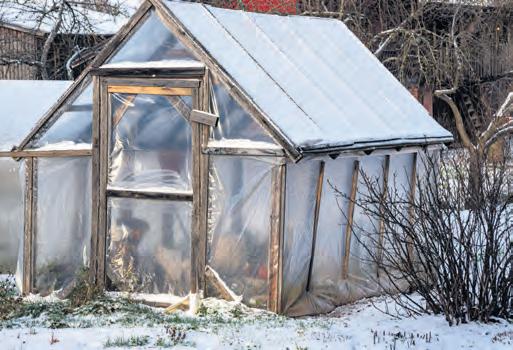
Autumn is often overlooked as a planting season, but it’s arguably the best time to plant many types of trees and shrubs. The combination of warm soil, cool air, natural rainfall, and reduced pest pressure creates perfect conditions for root establishment.
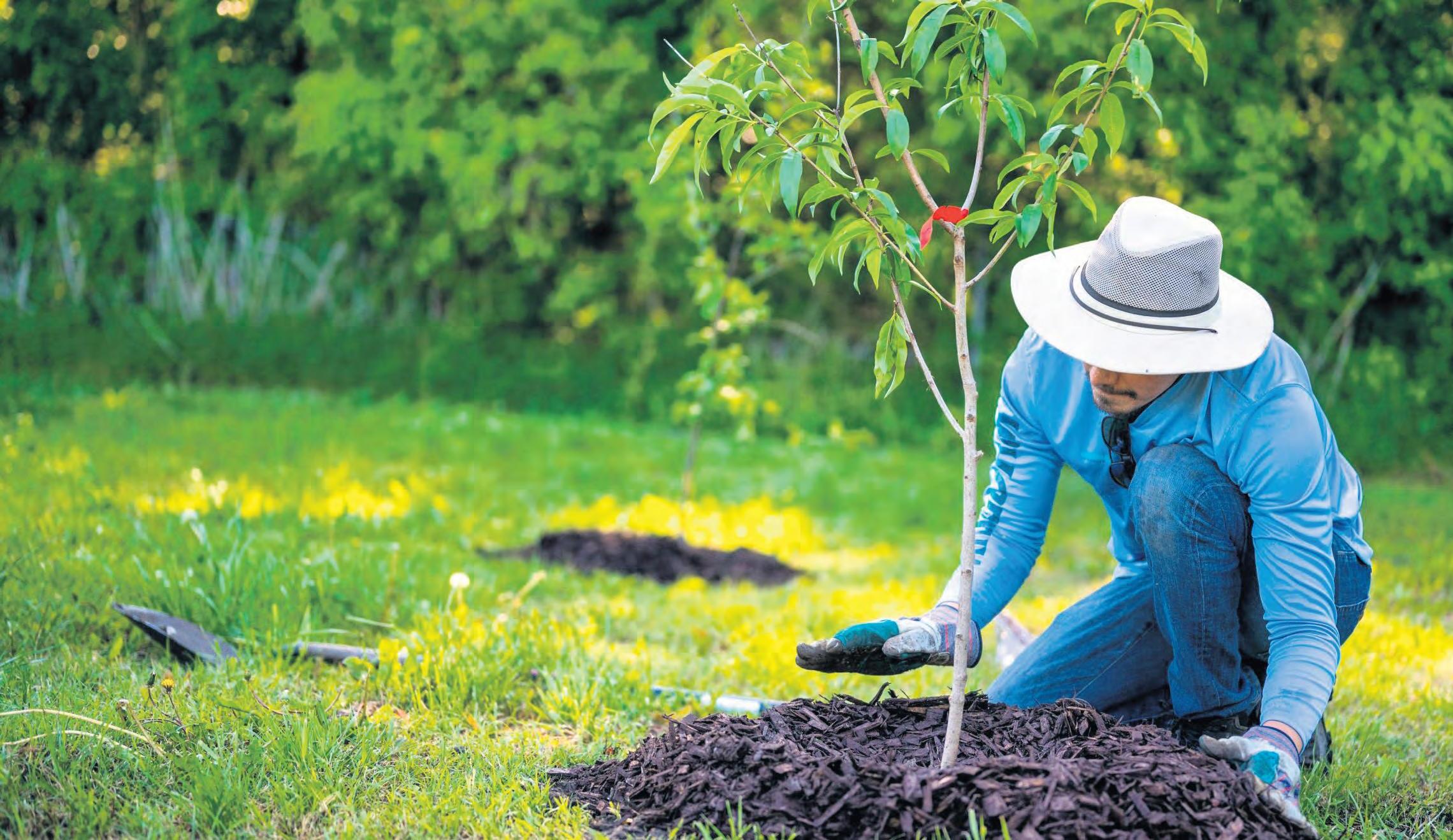
Planting trees and shrubs is one of the most rewarding tasks a gardener can undertake. Trees provide shade, beauty, wildlife habitat, and even help mitigate climate change by absorbing carbon dioxide. Shrubs add structure, privacy, and year-round interest to gardens and landscapes.
While many instinctively think of spring as the best time to plant, autumn is the ideal season for planting many trees and shrubs. This article explores why autumn is the best time to plant, looks at the types of trees and shrubs best suited to autumn planting, and gives a step-by-step guide to ensure success.
During summer, high temperatures and increased sun exposure can cause newly planted trees and shrubs to lose moisture rapidly, placing stress on the plant. In contrast, autumn offers cooler daytime temperatures and cool nights, which help reduce transpiration (moisture loss through leaves). This allows the plant to establish roots without the stress of trying to grow leaves or survive scorching heat.
Although the air is cooler in autumn, the soil remains warm from the summer heat for several weeks into the season. This warm soil provides ideal conditions for root development, which continues until the ground freezes. When planted in the autumn, trees and shrubs focus their energy on growing strong root systems rather than producing leaves or flowers, giving them a solid foundation for spring growth.
In many climates, autumn tends to bring increased rainfall, reducing the need for frequent manual watering. Consistent moisture supports root establishment without the risk of overwatering or drought stress that can be common in summer. Many pests and pathogens that thrive in spring and summer start to diminish in autumn. This reduced pest pressure gives young plants a better chance of survival without the need for chemical treatments or constant monitoring.
As the gardening season winds down, many nurseries and garden centres offer end-of-season sales on trees and shrubs. This makes autumn planting not just practical, but also economical.
Most deciduous trees and shrubs (those that lose their leaves in winter) can be planted successfully in autumn. Some evergreen species can also do well if planted early in the season.
Planting a tree or shrub might seem straightforward, but proper technique is crucial to ensure long-term health and growth.
Plants will not grow where soil contains too little air or where soil moisture is either excessive or insufficient. Pre-planting soil preparation should aim to improve these conditions.
Loosen the soil to a depth equivalent to the height of the rootball and over a wide area to eliminate compaction and improve drainage.
There is little evidence that adding extra organic matter to the bottom of the planting hole helps; in fact this practice can hinder plant establishment as the organic matter decomposes and may cause the plant to sink. It is not beneficial to apply fertiliser at planting time. However, on poor soils sprinkling an inoculant of mycorrhizal fungi may help trees and shrubs get established.
Various plants may be available bare root, including fruit trees, hedging plants and some perennials. They are generally cheaper than plants in containers, but are only available in winter/early spring, while dormant.
Aim to plant four to six weeks before the ground freezes. This gives roots time to establish. In most areas of the west country, this means planting between late September and early November.
Plant at the right depth. The root flare (where roots begin to spread from the trunk) should be just above ground level and avoid planting too deeply, which can suffocate roots and promote rot. Backfill with
the original soil, not compost or amendments. This encourages roots to grow into native soil. Use a slow, deep watering method, such as a soaker hose.
Apply a three-inch layer of mulch (wood chips, bark, or compost) around the base. Keep mulch inches away from the trunk to prevent rot and pests. Mulch insulates the soil, retains moisture, and suppresses weeds. Dig a planting hole that is no deeper than the roots, but is ideally at least three times the diameter of the root system. If the sides of the planting hole are compacted, break the soil up with a fork before planting.
In grassed areas circular planting holes are easier to mow around, but square planting holes aid root penetration at the corners on heavy soils. A square hole within a mowing circle combines the two.
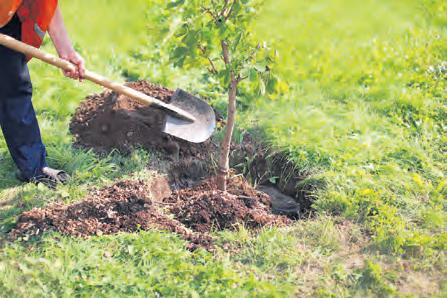

Soak bare-rooted trees or shrubs for about 30 minutes prior to planting. And give containerised plants a good water before taking them out of their pots.
Place the tree or shrub in the planting hole and position it so that the first flare of roots are level with the soil surface when planting is complete. With containergrown plants, the top layers of compost may need to be scraped away to reveal the flare of roots. Deep planting prevents essential air movement to the root system and makes the lower trunk vulnerable to disease - this can lead to poor establishment.
Insert a stake if required. Small trees do not require staking but top-heavy or larger specimens should be staked. Refill the planting hole carefully, placing soil between and around all the roots to eliminate air pockets. Firm the soil gently, avoiding compacting the soil into a hard mass and water in.
Drought stress is common with newly planted trees and shrubs. Even in a cool, wet summer, the rain rarely replenishes soil moisture stores fully. The soil may be dry around the roots even when the surface appears moist.
Dry, windy conditions are especially likely to lead to water shortages. With experience, it is possible to detect the dull, lifeless foliage indicative of drought stress but by then the tree has already been damaged. Ideally anticipate water loss, and irrigate to prevent damage.
FEEDING AND PRUNING
Fertilisers do not need to be added at planting time but can be used a season after planting if the soil is very poor or a boost to growth is required. Corrective pruning on misshapen trees is best carried out while the tree is still young. This may involve shortening or removing any competing leaders and removing damaged, dead or diseased wood. Lower laterals (i.e. sideshoots coming off the main trunk) may also need removing in stages over the first few years if a clear trunk is desirable.
• Monitor moisture, even in cooler weather, young plants need consistent moisture. Check soil moisture weekly by digging down a few inches near the root zone.
• Avoid fertilizing in autumn,fertilizers can stimulate new leaf growth, which is vulnerable to frost so wait until the following spring to fertilize, if needed.
• Protect from wildlife, use tree guards or mesh to protect from rabbits, deer, and rodents over winter.
• Mark plants clearly, use tags or stakes to avoid damaging them during winter snow removal or mowing.
• Inspect in early spring, once winter ends, check for signs of frost heaving (plants pushed out of the soil).Re-firm soil around the base if needed.
Planting too late: Wait too long and roots won’t establish before winter.
Overwatering or underwatering: Both can be fatal; monitor watering conditions regularly.
Ignoring soil quality: Compacted or poorly draining soils can stunt growth.
Not removing wrapping materials: Burlap, wires, and ties can strangle roots or trunks.
Planting too deep or too shallow: Either can result in poor growth or plant death.
These trees go dormant in the winter and are well-suited to autumn planting.
MAPLES– including red, sugar, and silver maples.
OAKS -such as red, white, and pin oaks.
BIRCHES– known for their striking bark and graceful shape.
LINDENS– fragrant flowers and heart-shaped leaves.
ASH – hardy and fast-growing (check for disease resistance).
CRAB APPLES– ornamental and pollinator-friendly.

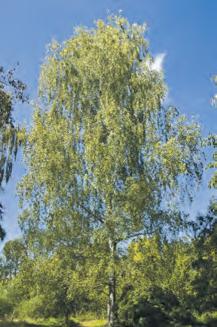
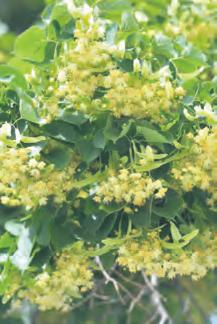

Many flowering and ornamental shrubs thrive when planted in the autumn.
HYDRANGEAS – Especially panicle and smooth types.
VIBURNUMS – Excellent for berries and autumn colour.
SPIREA – Tough and adaptable, great for borders.
NINEBARK (PHYSOCARPUS) – Adds colour and texture.
DOGWOOD SHRUBS (CORNUS SPP.) – Beautiful red stems in winter.
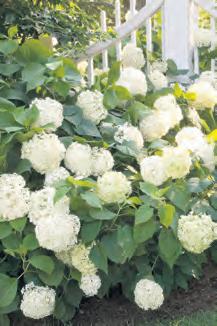
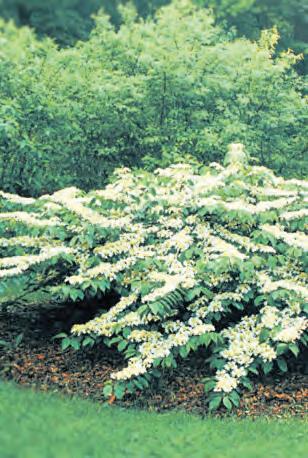
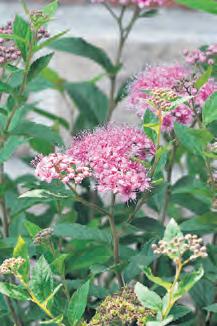
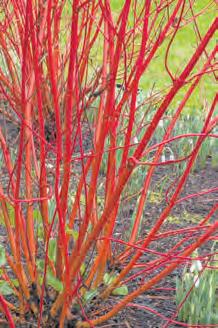
Evergreens can be planted in autumn but require more care to avoid winter burn.
BOXWOOD– popular for hedges and topiary.
HOLLY – offers winter interest with red berries.
JUNIPERS– drought-tolerant and hardy.
YEW dense and shade-tolerant.
Evergreens should be planted at least six to eight weeks before the first hard frost to allow adequate root establishment.
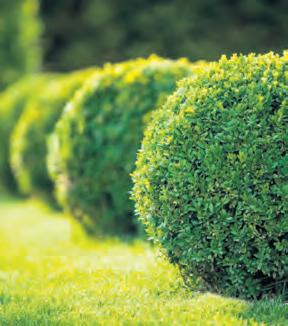
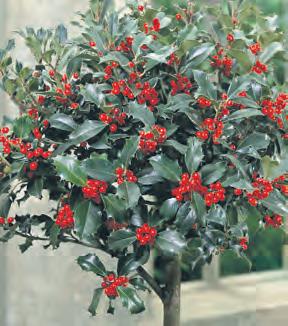
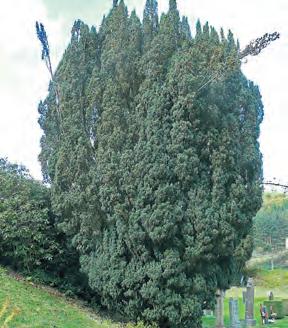

The fallen leaves of autumn which will be all around us soon aren’t litter - but a goldmine for gardeners. Far from being waste, leaves are a free, natural, and rich resource for creating one of the best soil conditioners available.
Leaf mould is simply decomposed leaves. When left to break down over time typically one to two years leaves transform into a dark, crumbly, sweet-smelling material similar in texture to compost. However, unlike compost, which is rich in nutrients due to the breakdown of various organic matter, leaf mould is more of a soil conditioner than a fertilizer. It improves soil structure, enhances moisture retention, and fosters the health of beneficial organisms like earthworms and microbes.
Used as a mulch, seed-starting mix, or a soil amendment, leaf mould is especially prized in organic gardening. It’s gentle, natural, and free to make if only more people realized its worth.
The idea that fallen leaves are litter is a horticultural misunderstanding. In natural ecosystems, leaves fall to the ground and begin their slow journey of decomposition. They provide shelter for insects, food for fungi and bacteria, and eventually return nutrients to the soil. This cyclical process supports the health of forests and gardens alike.
Unfortunately, in towns leaves are often treated as rubbish. They’re raked up, stuffed into plastic bags, and sent to landfills where they decompose anaerobically, releasing methane—a potent greenhouse gas which represents a missed opportunity to recycle nutrients back into the soil.
Reframing our view of leaves from waste to resource is the first step in embracing more sustainable gardening practices. Embracing leaf mould production can reduce the environmental impact of garden waste. Municipal leaf collection and disposal require fuel, labour, and landfill space. By keeping leaves on-site and returning them to the soil, gardeners can significantly reduce their carbon footprint.
Some communities have begun to promote leaf recycling programmes or encourage residents to mulch leaves directly into lawns or create communal composting areas. Sharing this knowledge with neighbours, schools, and local garden groups helps shift perceptions and build more sustainable communities.
The next time you see your garden covered in leaves, consider the quiet potential of those fallen fragments. They’re not litter—they’re future soil, moisture-holding mulch, and life-giving humus in the making.
By collecting and composting leaves into leaf mould, you’re not only improving your garden— you’re participating in a natural cycle that supports biodiversityand reduces waste.
Improves soil structure
Leaf mould increases the crumb structure of soil, allowing for better aeration and drainage in clay-heavy soils, and improving moisture retention in sandy soils.
Increases water retention
Studies have shown that leaf mould can hold up to 500% of its own weight in water. this is especially beneficial in dry climates or during summer droughts.
Encourages beneficial soil life
As leaves break down, they foster a rich community of fungi and microbes. These, in turn, support plant health by creating a more balanced and resilient soil ecosystem.
Suppresses weeds and mulches plants
Used as a top layer, leaf mould helps suppress weed growth, regulate soil temperature, and retain soil moisture around plants.
Cost-effective and sustainable
Making leaf mould costs nothing but a bit of time and space. it’s a great way to reuse what nature provides, reducing the need for store-bought soil amendments.

Creating leaf mould is one of the simplest composting processes there is. Not all leaves are created equal. Leaves from deciduous trees like oak, maple, beech, and hornbeam break down well and make excellent mould. Avoid tough, waxy leaves like holly or evergreen needles, which take much longer to decompose. You can still use them, but shred them first or mix them with faster-decaying leaves.
Shredding the leaves before composting them increases their surface area and helps them break down faster. You can use a mulching mower, leaf shredder, or even run a weed trimmer in a bin of dry leaves.
You can pile leaves in a corner of the garden, or better yet, use a simple bin made of wire mesh, wood slats, or pallets. The bin should allow for good air flow to encourage aerobic decomposition.
Leaves need moisture to break down. If your leaf pile gets dry, water it occasionally. The pile should be as damp as a wrung-out sponge. If it’s too dry, decomposition slows to a crawl.
Unlike traditional compost, which can break down in a few months with proper management, leaf mould is a slower process. Depending on the type of leaves and whether they’re shredded, it may take anywhere from six months to two years for the leaves to fully break down into mould.
Once your leaf mould has matured into a dark, crumbly substance, it’s ready to be used:
• Mulch: Spread it around flower beds, vegetable patches, and shrubs to retain moisture and suppress weeds.
• Soil onditioner: Work it into the top few inches of soil to improve structure and water retention.
• Seed starting mix: Mix with compost or sand for a gentle, nutrient-light seedling mix.
• Potting soil additive: Blend into potting mixes to improve aeration and structure.
Somerset based Miriam French looks back on 18 months when she tried hard to create a garden in the heat and dramatic weather of Texas
When I moved two years ago from the green and beautiful Quantocks to the vast, sundrenched plains of Central Texas, I imagined I’d simply plant my favourite cottage garden blooms and settle in with a cup of tea under the shade of a rose-covered arbour. Reality, of course, had other plans.
I am home now and can look back on 18 months of a real overseas gardening experience. My first year gardening 30 miles south of Dallas on a one-acre plot alongside our rented temporary home was a year of sunburns, clay soil, confused perennials, and an education in resilience not just for the plants, but for the gardener too.
January to March: a false spring and a sudden freeze
In England, the winter garden is a sleepy, serene place, but in Texas, January days can suddenly reach the mid-70s (24°C) and coax tender leaves from plants that should know better. Encouraged by the warmth, I planted out snapdragons, violas, and a few early tomatoes in February. Then came March—and with it, a hard freeze that wiped out most of my hopeful efforts. I quickly learned to be suspicious of Texas spring. A local gardener gently told me : “Don’t plant your tomatoes until after Easter.” It’s advice I now take seriously.
April to June: bursts of bloom and the heat to come
By April, the garden transformed. My salvaged snapdragons bounced back, and the bluebonnets, Texas’s proud state flower spread across roadsides and, to my delight, my garden beds. I discovered native plants like Indian blanket (Gaillardia) and winecups, which bloomed without fuss. Roses that had sulked through March now burst into life, and I managed a short season of lettuce, peas, and kale before the heat began to rise.
In May, the temperatures soared into the 90s (32°C+), and I watched helplessly as my English foxgloves withered. I replaced them with lantana and zinnias, which thrived where my English favourites failed. By June, it was clear: gardening in Texas isn’t about forcing the land to be English; it’s about embracing what flourishes here.

July to September: surviving summer
Texas - land of blistering summer temperatures and second springs
Texas summer is not for the faint-hearted. July arrived with triple-digit heat, and my gardening activities became limited to early mornings and late evenings. I invested in soaker hoses and mulch,lots of mulch, to preserve what little moisture the soil retained. Bermuda grass flourished whether I wanted it or not, and my tomatoes stopped setting fruit entirely once nighttime temperatures stayed above 75°F (24°C).
But there were joys, too. Okra thrived, as did peppers, basil, and eggplant. The crepe myrtle trees bloomed with outrageous confidence, and the butterflies—giant swallowtails and monarchs—floated through the garden. I began to appreciate the fierce beauty of a Texas summer and the plants that could withstand it.
October to December: second spring
In England, the gardening year winds down in autumn, but Texas surprises you with a second spring. October brought cooler days and even a bit of rain. My roses flushed with new blooms, and I replanted cool-season vegetables like spinach, broccoli, and carrots. Autumn is the best gardening season there—milder temperatures, fewer pests, and a chance to try again.
I learned to lean into the seasons, to grow native and heat-tolerant plants, and to respect the power of the Texas sun. I discovered that gardening there is more dramatic, more challenging, and somehow more rewarding. It may not look like an English garden, but it is just as full of life, colour, and joy—just in a different accent.







There’s something deeply comforting about autumn — the way the air turns crisp, the light softens, and gardens seems to quieten after the frenetic energy of summer. Among the greatest joys of the season is visiting gardens as they don their autumn colours, a final, fiery celebration before winter’s stillness sets in. Combined with the earthy pleasure of a bowl of warming soup afterwards, it becomes a ritual that nourishes both body and soul.
Autumn gardens are nothing short of magical. As the season unfolds, nature puts on a dramatic show. Leaves turn from green to a rich palette of ochre, russet, gold, and crimson. Japanese maples glow like lanterns against the fading light, while beech and oak trees rustle in the breeze with their coppery cloaks. The air carries a scent of damp earth, drying leaves, and distant wood smoke an aroma unique to this transitional time.
Wandering through a garden in autumn is like stepping into a painting. The softened light filters through thinning canopies, casting dappled shadows on mossy paths and fallen leaves. Each footstep crunches satisfyingly, and every turn in the path reveals new colours, textures, and perspectives. Even the quieter parts of the garden the emptying beds and wilting stems carry a quiet, meditative beauty.
But autumn gardens are not only about what fades; they also surprise with what endures and emerges. Late-flowering plants like dahlias, chrysanthemums, and sedums bloom defiantly, offering bursts of colour against a backdrop of decay. Ornamental grasses sway gracefully in the wind, catching the low light with silvery plumes. It’s a time for berries too rowan, holly, and crab apple trees gleam with red and orange fruit, attracting birds and lending a festive air. After an invigorating walk through such beauty, there’s nothing more comforting than returning indoors to a bowl of warming soup. The chill in your fingers and nose only enhances the pleasure of holding a steaming mug, the warmth seeping through your skin as the scent of spices, herbs, and vegetables fills the room. Soup in autumn isn’t just a meal; it’s a restorative experience.
Whether it’s a velvety butternut squash soup with a hint of nutmeg, a hearty lentil stew with smoked paprika, or a rustic mushroom broth rich with garlic and thyme, soups echo the season. They are earthy, simple, and nourishing — the culinary equivalent of a woollen jumper. Made with seasonal produce like pumpkins, carrots, leeks, and potatoes, they celebrate the harvest and invite creativity. Add a slice of crusty bread, a swirl of cream, or a sprinkle of cheese, and you have a dish that warms from the inside out. Together, autumn gardens and warming soups offer a rhythm of pause and presence. In a world that often rushes forward, this seasonal pairing invites us to slow down and savour the moment. There’s a deep-rooted pleasure in watching the world turn amber, feeling the crunch of leaves beneath your boots, and then sitting by a window with soup in hand, watching the wind rustle the branches. Ultimately, it’s about connection — to nature, to the seasons, and to ourselves. Visiting gardens in their autumn splendour reminds us of the beauty in letting go, the richness in change. And soup, humble and grounding, reminds us of the joy of simplicity.
Enjoy tranquillity, autumn colours and warming soups at Lukesland Gardens, Ivybridge
Tucked away on the southern edge of Dartmoor, just north of Ivybridge, Lukesland is a wonderful place to enjoy autumn colour. The shelterbelt of beeches, planted by the Victorians to protect this 24-acre garden from Dartmoor winds, turns to gold, while more exotic species such as acers, cercidiphylum, cornus, enkianthus, ginkgo and swamp cypress reflect their autumn tints in the pools of the Addicombe Brook. Visitors often comment on how peaceful the garden is, with the gentle sound of the tumbling stream constantly in the background, as you wander on twisting paths through this woodland valley, with new views around every corner.
Openings are on Sundays and Wednesdays 11am to 5pm from 5th October till 16th November. No pre-booking is required. The tearoom is open with a simple menu of home-made soup and cakes. There is also a fun trail for children.
Dogs are welcome on a lead.
For more details about Lukesland telephone 07479 383531or go to www.lukesland.co.uk Lukesland Gardens, Lukesland House, Ivybridge PL21 0JF
By exploring Westonbirt’s world famous autumn colour you are invited to deepen your connection with Westonbirt’s living collection and take a creative journey!
This year look beyond the vibrant autumn colours and observe the finer details of nature.
Be inspired by the outdoor exhibition from ‘Bedgebury National Pinetum Florilegium Society’, featuring 18 exquisite botanical illustrations. Also explore the Drawn to Nature trail or The Art of autumn family trail in the Old Arboretum, showcasing several of the species in the exhibition.
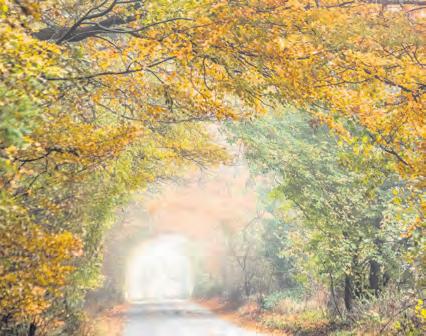
Let nature’s fireworks spark your creativity, observation, and imagination as you explore their autumn exhibition and trails that will take you on a hands-on adventure celebrating the season’s spectacular colours. With a sketchbook and your colour pencils in hand, explore your artistic side, capturing the textures, shapes, and stories of the trees around you.
Westonbirt Arboretum, Tetbury GL8 8QS To find out more see: forestryengland.uk/westonbirt/autumn
Batsford Arboretum is renowned for its breathtaking autumn display, with vibrant bursts of colour from Japanese maples, sorbus, euonymus, and cherry trees. Wander through 60 acres of enchanting pathways, surrounded by a dazzling palette of reds, pinks, and golds set against the rolling Cotswolds countryside.
After exploring the grounds, browse the garden centre for essentials and a wide range of high-quality plants. Complete your visit with a treat at the Garden Terrace Café, where you can enjoy a hearty breakfast, a freshly prepared lunch, or a relaxing afternoon tea.
Batsford Arboretum & Garden Centre, near Moreton-in-Marsh, Gloucestershire GL56 9AT Tel: 01386 701441 Book your visit to the arboretum in advance via www.batsarb.co.uk
Soak up the spectacular colour... at Batsford this autumn, browse our garden centre and gift shop and enjoy delicious food from our café. A perfect day out for all the family – including the dog!
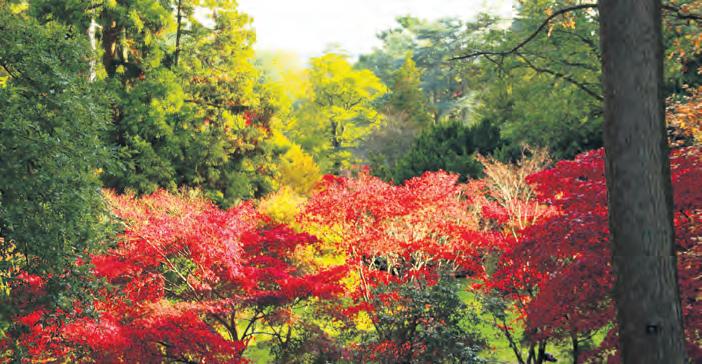
www.batsarb.co.uk
BATSFORD ARBORETUM AND GARDEN CENTRE Batsford, Moreton-in-Marsh, Gloucestershire GL56 9AT.
Tel: 01386 701441 E: arboretum@batsfordfoundation.co.uk
BatsfordArboretum@BatsfordA
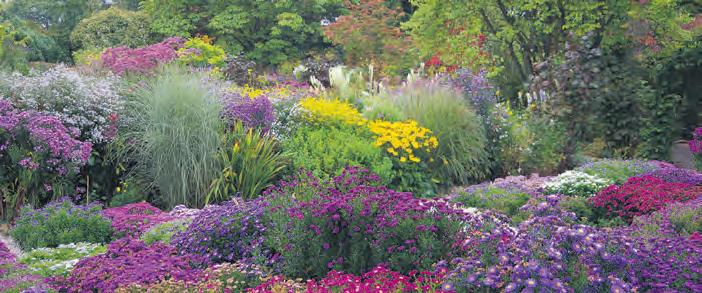

The Michaelmas Daisy Specialists since 1906 Old Court Nurseries & The Picton Garden
Specialist nursery and beautiful 1.5 acre garden just waiting to be explored ORDER ONLINE or catalogue available by request.
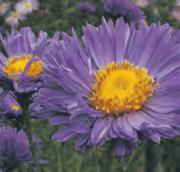

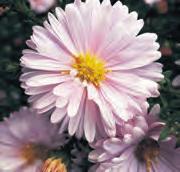
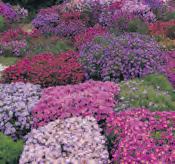
Open daily, 11am to 5pm until 20th October. Garden admission £5
Open TUESDAY 14TH OCTOBER for the National Garden Scheme

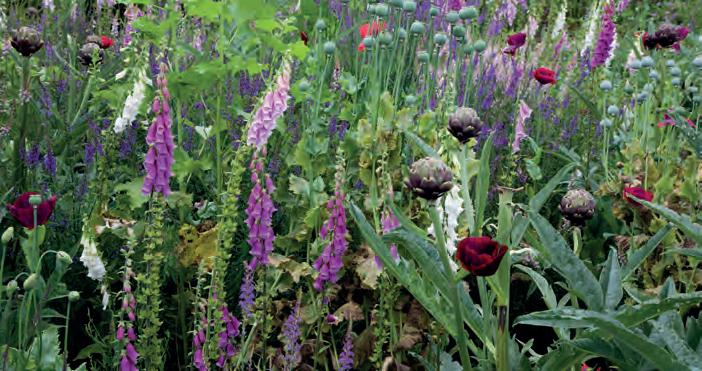

Pre-order your essential garden visiting guide: the Garden Visitor’s Handbook 2026 ngs.org.uk/shop
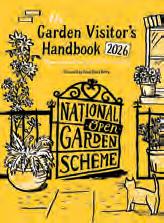

Acer palmatum varieties
OPENING TIMES: Closed for winter. Open throughout February and March, Thursday-Saturday, 11am -4pm We produce and grow the largest selection available in the UK. Plants are pot grown and suitable for garden, patio or bonsai. Visitors welcome Mon-Sat 9am-1pm & 2pm-4pm
Barthelemy & Co (DCG), 262 Wimborne Rd West, Stapehill, Wimborne, Dorset BH21 2DZ

Court Nurseries,
WR13

Tel: 01202 874283 enquiries@barthelemymaples.co.uk www.barthelemymaples.co.uk

Barthelemy & Co near Wimborne in Dorset was established by a French nurseryman almost a century ago and the Skinner family now specialise in propagating and growing Acer palmatum – or Japanese maples as they’re known. Throughout spring, summer and autumn the delicate foliage of the acer presents exquisite shadings of Mother Nature’s gold, pink, purple, green, yellow, orange and red. Acers are a delightful addition to anyone’s garden, giving an aura of peace and tranquillity. The ten-acre nursery at Stapehill has a huge collection of Japanese maples to choose from and expert staff are on hand to help select the right variety and to offer advice about caring for the trees in future. Over 100,000 acers are produced at Barthelemy and Co every year approximately 10,000 - 12,000 of them are grafted named palmatum varieties, as one of the largest specialist growers of their kind.
Barthelemy & Co, 262 Wimborne Road West, Wimborne, Dorset BH21 2DZ Tel: 01202 874283 www.barthelemymaples.co.uk
As the garden opening season draws to a close it’s time to start looking forward to next year! You can now pre-order the National Garden Scheme Garden Visitor’s Handbook 2026 - your essential guide to over 3,500 gardens opening next year, and plan what delights you are going to explore. With detailed descriptions of every garden, stunning photos, and handy maps and calendars, all the information you could possibly need is right at your fingertips! And with Christmas approaching why not browse our shop for our gorgeous range of Christmas cards, and beautiful gifts inspired by our gardens and nature. Every purchase in aid of the National Garden Scheme.
Visit our online shop: www.ngs.org.uk/shop
Nestled in the foothills of the Malverns you will find The Picton Garden, home to more than 400 varieties of Michaelmas Daisy. Uniquely it is in August that this one-and-a-half-acre plantsman’s garden begins to glow with the first of the Asters and autumnal herbaceous, as autumn advances the colours intensify reaching a crescendo in late September and the first week of October. Afterwards the interest is carried on by the unusual trees and shrubs, chosen for their autumn colour, as well as late flowering bulbs, herbaceous and beautiful ferns. The adjacent nursery is well stocked with many of the plants seen in the garden. Telephone 01684 540416 www.oldcourtnurseries.co.uk
Autmn colours galore at Kingston
Autumn at Kingston Lacy is bright, bold and beautiful. Visit the Japanese Garden, where the acers are firing up in all shades of red and orange and the bamboos rustling in the wind. The Lime Avenue gradually turns shimmering yellow, while the Woodland Walk, with its mighty oaks, is the perfect place for an autumnal stroll. From the strong colours of dahlias to delicate cyclamen tucked away in the Fernery, you’ll find plenty of ways to celebrate the season at Kingston Lacy.
www.nationaltrust.org.uk/kingston-lacy

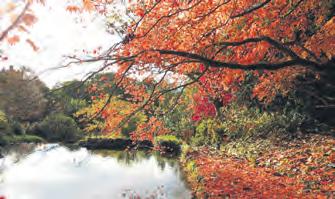

Visit
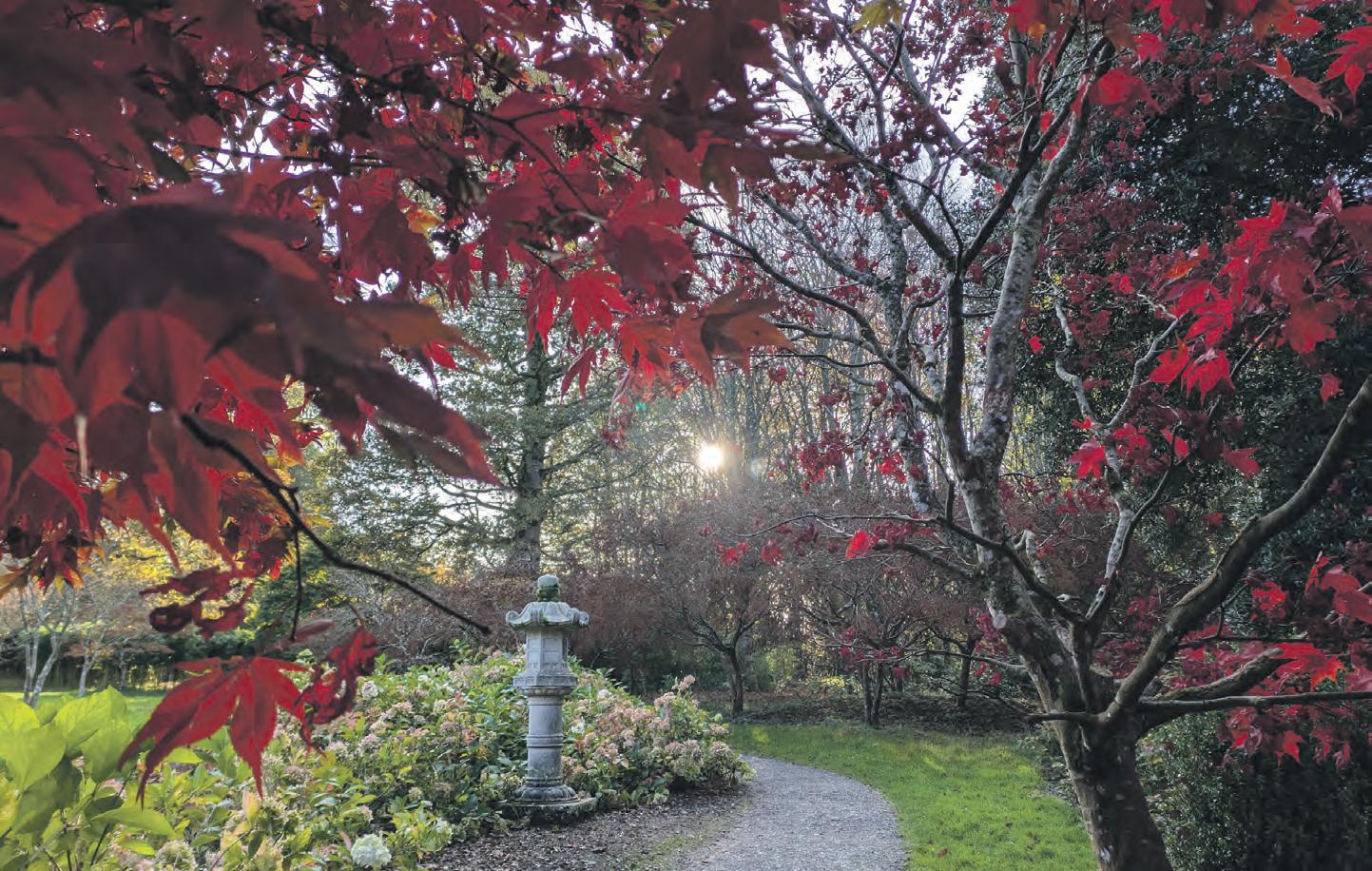

If you would like to write to us with your views or ideas on any gardening subject, then email editorial@countrygardener.co.uk
This summer, I decided to leave a small gap under my back fence, and to my delight, a hedgehog took up residence in the garden! I’ve always admired them but never had one visit regularly until now. I think the wildflower border I planted last year has helped, as it attracts plenty of insects and the hedgehog seems to spend a lot of time there. I just wanted to encourage fellow gardeners who have a quiet corner, consider making it hedgehog friendly. A simple log pile and bits and pieces of twigs seem to do the trick.
Margaret Davison Poole

After years of wrestling with heavy clay soil, I finally got round to building three raised beds this spring and I’m kicking myself for not doing it sooner! The difference has been remarkable. Carrots that actually look like carrots, fewer weeds, and no more backache. I filled them with a mix of topsoil, compost, and sand, and even managed to grow a decent crop of beetroot, which never thrived before. There’s also a nice feeling about the beds being self-contained and I can deal with them one at a time rather than the garden as a whole. For anyone on the fence about raised beds: do it.
Colin French Minehead
I just wanted to say thank you for your tip in the June issue about pinching out the side shoots on cordon tomatoes it made a noticeable difference to my crop! For the first time in years, I’ve got healthy plants and a decent yield. That said, I still struggle with splitting skins after a sudden downpour. A neighbour swears by mulching heavily to maintain moisture levels. I might give it a go next year. Has anyone else had luck with this?
Derek Smythe Dunster
I was sorry to read Deborah’s story about losing her Somerset gardening club in the August edition of Country Gardener.
We too have a small village community of about 550 and our club celebrates a 25th anniversary next March. We have about 60 members whom attend monthly meetings, garden visits, Christmas lunch at a local venue, day trips and from 2012 our annual coach holiday organised by us. Next year over 20 of us are going on a cruise to see the bulb fields near Amsterdam.
We established in the early years members did not want an annual show, although we did have one low key one, but never again. Nor do they like quiz evenings. Members are encouraged to give us views on what subjects they want to hear about at meetings. Our committee works very hard to find speakers. Based in North Devon there are very few local speakers and the ones we have found have
been asked to return. Many of the speakers do not want to travel as we are a distance from them or if they are willing the travel costs make it expensive.
It’s hard work but we manage to fill a year’s programme with some associated subjects – hedgehogs, wreath making, bee keeping, climate change, beneficial insects to name a few. We too have had some poor visiting speakers, but most have been interesting and engaged with members.
Members bring along surplus plants, seeds and books that sell for a reasonable amount and this helps keep our income rolling in to afford speakers.
We are also an aging population and have picked up members from the local area where other gardening clubs have closed and members have brought friends along who then join. We are lucky that a couple of our younger (in their sixties) members have now joined the committee.
Janet Oades
via email

We moved to Devon in 2015. We have a four-acre garden which was planted with about 100 trees in the 1960's. About 20 of these are ash (Fraxinus excelsior). None were showing any symptoms of the disease. Now in 2025 about half of the ash trees are showing symptoms. One has died and one is close to death. The 'close to death' tree throws out 'water shoots' every year but won't last for much longer. The remaining ash trees in our garden don't show any symptoms. When the latest Dutch Elm Disease appeared, I was managing a 60acre ornamental tree nursery in Bagshot. We were growing Ulmus x hollandica 'Groenveld' and Ulmus x hollandica 'Commelin'. These were resistant to the existing Dutch Elm Disease. Unfortunately they weren't resistant to the new type. As Mark Hinsley says, they were raised as members of a clone and genetically identical. They all died. Rows of trees infected by the beetle which was clearly visible burrowing into the trees just under where the branches meet the main stem.
I agree with Mark there will be survivors of ash dieback. In my experience in Devon more survive than die. The survivors are seeding for the next generation of survivors!
On a sad note, ash produces the best logs for our wood burner.
Chris Adam Tiverton
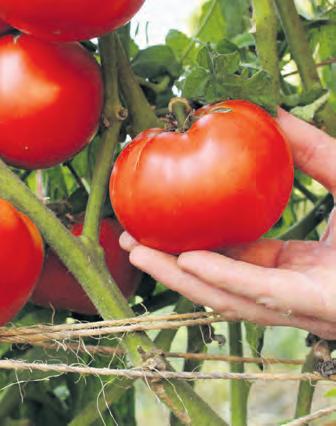
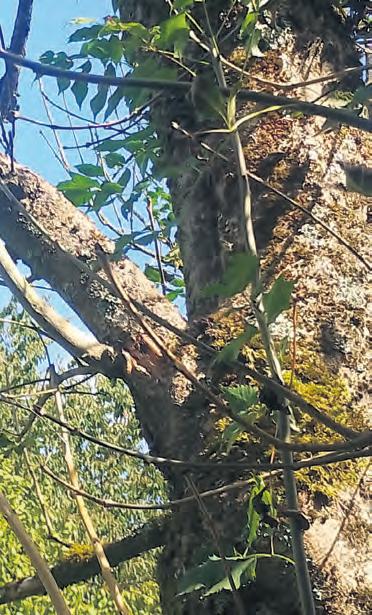
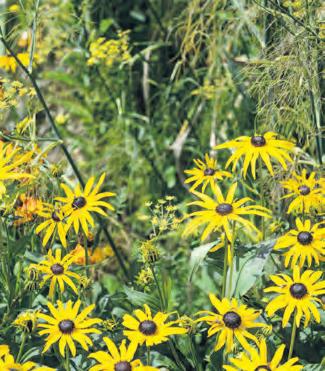
With the extremes in weather this year I had resigned myself to a fairly bland flowerbed. But to my surprise, my salvias and rudbeckias have burst into colour in late August and are still going strong! I’m learning to appreciate the value of late bloomers—they’ve brought bees, butterflies, and a splash of joy just when the rest of the garden is fading. I think we gardeners do not appreciate enough the way we can extend colours into the autumn.
Anya Davies Dorchester
Planting fruit trees in the autumn is a strategic and beneficial choice for gardeners While spring is often seen as the ideal time for planting, autumn offers unique advantages that can lead to healthier trees, better yields, and long-term success.
One of the main reasons autumn is ideal for planting fruit trees is the favourable weather conditions. During this season, the soil remains warm from the summer months, which encourages root development even after the leaves have dropped. As the air temperature cools down, the tree’s energy is directed toward establishing strong roots instead of producing leaves or fruit. This root growth continues throughout the winter in many climates, giving the tree a head start when spring arrives.
Another advantage is the increased
availability of moisture. Autumn typically brings more rain, reducing the need for frequent watering by the gardener. Consistent moisture helps newly planted trees settle into the ground more effectively, minimizing transplant shock and promoting healthier growth. Additionally, since evaporation rates are lower in cooler weather, the soil retains moisture longer, which benefits root development.
Planting fruit trees in the autumn also gives them more time to acclimate to their environment before the stress of summer heat. Trees that are planted in autumn are better prepared to handle the heat and potential drought of the following summer, as their root systems are already more established. This can lead to improved growth, increased resilience to pests and diseases, and even earlier fruit production.
Walcot Organic Nursery, located in the Vale of Evesham, will be supplying all sorts of fruit trees over the winter months. Grown in the soil, they are available bare rooted when dormant until late March – natures time for tree planting.
Choose from a wide selection of organically-grown apples, pears, quinces, plums, damsons and more. Plant, then with a little training, look forward to enjoying delicious fruit in the future!
With Christmas in mind, or at any other time, why not encourage others around you to plant some fruitful trees with a gift voucher?
Orders may be made via the website www.walcotnursery.co.uk, over the phone 01905 841587 or in person. The website provides much advice on choosing and growing fruit trees. A paper catalogue is also available.
Adam’s Apples Nursery is an organic fruit tree nursery in East Devon, growing the largest range of fruit and nut trees for sale in the south west. A traditional bare-root nursery, trees can be ordered through the year and are available for planting during the winter months. Specialising in south west, heritage and traditional varieties, they have an extensive range across all fruit tree types, including cider apples. Collection or national delivery available. adamsappletrees.co.uk 07521 648502 sales@adamsappletrees.co.uk













Growing sweet peas (Lathyrus odoratus) in autumn offers gardeners lots of good news that can lead to stronger plants, earlier blooms, and a more rewarding gardening experience overall.

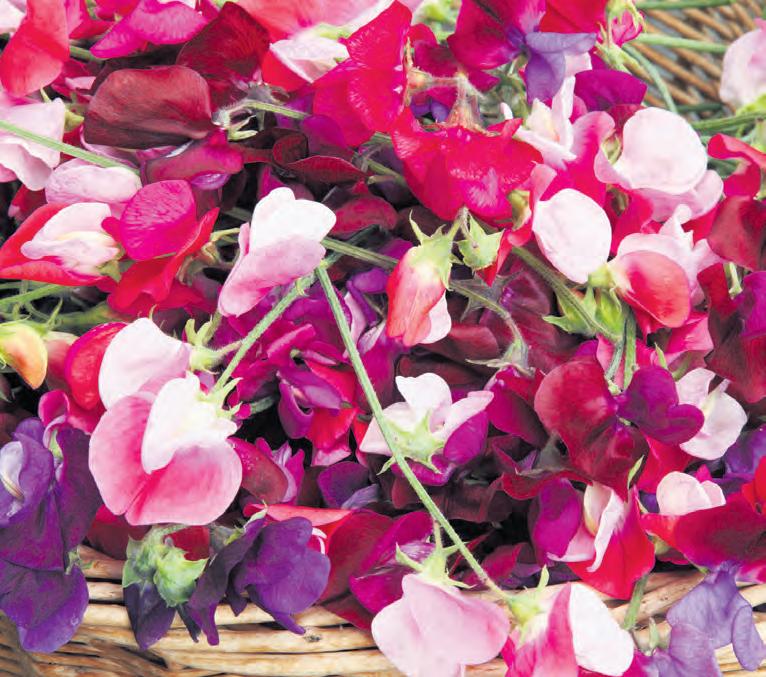
While traditionally thought of as a springtime flower, autumn sowing of sweet peas is a time-tested technique, popular among experienced gardeners and in mild winters.
One of the most significant benefits of sowing sweet peas in autumn is the extended period allowed for root development. While top growth slows down during winter, roots continue to grow underground, especially in temperate climates. This head start helps the plants establish a solid root system before spring, leading to stronger, more vigorous growth once temperatures begin to rise.
These well-established roots help the plant cope better with early spring weather fluctuations and allow it to draw up nutrients and water more efficiently, supporting larger, healthier blooms later in the season.
Sweet peas grown in autumn often flower several weeks earlier than their springsown counterparts. This means gardeners can enjoy beautiful blooms from late spring onwards, rather than waiting until early summer. Early flowering is particularly desirable for those who want to make the most of their garden’s blooming season or who grow sweet peas for cutting or exhibition purposes.
up valuable greenhouse or propagator space in early spring for other crops like tomatoes, chillies, or cucumbers. This helps streamline your gardening workflow and ensures you’re not juggling too many seed trays at once during the hectic spring rush.
Autumn sowing aligns well with the sweet pea’s natural lifecycle. In their native habitats, many sweet peas are naturally cool-season growers, germinating with autumn rains and flowering as temperatures rise in spring. By mimicking this pattern, gardeners can tap into the plant’s evolutionary strengths, leading to healthier and more productive plants. Sweet peas are beloved for their fragrance and are popular cut flowers.
Autumn-sown plants, due to their earlier and more prolonged flowering period, produce more blooms over the season. This means more bunches for the vase and potentially a longer window for harvesting stems if you’re selling flowers or simply love having them indoors.
Autumn-sown sweet peas can also have an advantage when it comes to avoiding pests. For example, aphid populations tend to be lower during the cooler months, giving young plants a chance to establish without the early stress of insect attack.




Walcot Lane, Drakes Broughton, Pershore, Worcs WR10 2AL
www.walcotnursery.co.uk



Bare
Bare
Earlier blooms also avoid the hottest part of the summer, which sweet peas typically dislike. Sweet peas tend to struggle or stop flowering during prolonged heatwaves, so autumn sowing allows you to enjoy their peak beauty before the harshest summer temperatures arrive.
Autumn growing of sweet peas is a smart strategy. By taking advantage of the cooler months for root development and plant hardening, gardeners can enjoy stronger plants, earlier blooms, and a more efficient gardening schedule.
Traditional & heritage varieties Grown in Devon
Bulk
Traditional & heritage
Bulk discounts available UK delivery
Autumn-sown sweet peas are generally hardier and more robust than those sown in spring. Exposure to cool temperatures early in their development encourages the plants to grow stockier and tougher, better able to withstand pests, wind, and other stresses.
When grown under cold frames, in unheated greenhouses, or even directly in the ground in milder climates, sweet peas experience a natural ‘hardening off’ process.
adamsappletrees.co.uk
Tel. 07521 648 502 sales@adamsappletrees.co.uk adamsappletrees.co.uk Bare Rooted Fruit Trees Traditional
Another often-overlooked benefit of autumn sowing is garden scheduling. By starting sweet peas in autumn, you free
Why sow autumn sweets peas
• Better root development
• Earlier flowering
• Tougher plants
• Less competition in the garden
• Natural growth cycle
• Ideal for cut flowers
• Pest and disease avoidance

As the leaves turn and the days shorten, a shift begins—gardeners start tucking their plots in for winter while holiday planners eye the calendar, noting how quickly December is approaching. If you’re someone who enjoys giving thoughtful, personal gifts, now is the perfect time to get ahead. Especially when it comes to gardening gifts, local interest books, and even your Christmas tree, early planning can lead to better choices, less stress, and deeper seasonal joy.
Gardening may seem like a springtime pursuit, but the heart of a gardener is always thinking ahead. For many, the garden is a year-round passion. Whether it’s preparing raised beds for winter crops, sowing cover crops, or simply dreaming of spring, there’s no wrong time to gift something green-thumbed.
Buying gardening gifts early in the season offers a number of advantages: As more people shop online or locally, the most desirable or unique items can sell out quickly. From heirloom seed kits to handcrafted tools, early buyers get the first pick. Starting early gives you the luxury of time. You can find personalized items like engraved garden markers, custom plant stakes, or even locally made pottery for indoor plants.
Some gardening gifts are best given in the colder months, such as winter-growing kits, seed calendars, or gardening journals that start in January.
Look for gifts that bring joy now but also promise growth and beauty in the spring. Items like amaryllis bulbs, bonsai starter kits, or indoor herb gardens are ideal for winter gifting—they’re beautiful, engaging, and perfectly timed for a season when outdoor gardening slows down. Don’t wait for your Christmas tree
One of the most overlooked early-bird gifts? The Christmas tree.
Whether you’re buying a live potted tree, a sustainably harvested fir, or even a high-quality artificial one, getting your tree early is becoming more important each year. In recent seasons, many families found themselves scrambling due to shortages in both real and artificial trees—especially those wanting specific sizes or types
Local farms and sellers often allow early reservations, giving you the best shot at a lush, symmetrical tree. By buying early and locally, you’re often supporting small tree farms


1st Mar - 30th Sept Mon - Sat: 9am - 5pm Sun: 10am - 4pm
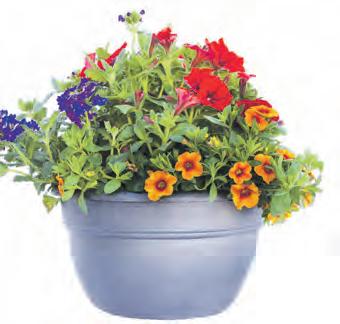
1st Oct - 21st Dec Mon - Sat: 9am - 4pm Sun: 10am - 4pm
CHRISTMAS TREES ON SALE FROM FRIDAY 21ST NOVEMBER
Kings Weston Road, Bristol BS11 0XF
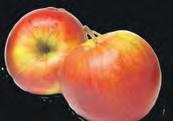



rather than big-box stores. Many offer live trees that can be planted after the holidays, which is a perfect gift for eco-conscious recipients. If you’re buying a cut tree, early options are often the freshest. If artificial, the best models sell out quickly.
If you have gardening friends, a living Christmas tree—a potted evergreen that can be transplanted later—can be a stunning, meaningful gift. Pair it with a local gardening book or a personalized ornament, and you have a memorable, eco-friendly present.
Another often-overlooked category for early gifting is local interest books—a truly personal and thoughtful gift, especially for gardeners and nature lovers. Local books often explore the flora, fauna, history, and stories of a specific region, making them highly relevant and special.
Pairing a local book with a gardening gift—like seeds of native plants, a map of nearby trails, or a small handmade bookmark—is an easy way to create a gift bundle that feels curated and meaningful.
Gardening, after all, is about patience and anticipation. So is the holiday season. By buying early, you allow yourself—and those you love—the space to enjoy it all.
Looking for a different book about Dorset?

Downstream Dorset, River Tales and Local History provides a colourful and inspiring exploration of Dorset with its many rivers and riverside towns and villages. Readers will be surprised by some lesser-known tales and gems from Dorset’s rich history!
Author Mary van Coller has travelled the county, exploring riverside communities and taking photographs, before being published by Spiral Publishing Ltd. t’s just £22.95 from local shops and garden centres or order online (+p&p) from www.downstreamdorset.co.uk or www.spiral-books.com
Twenty per-cent of all proceeds is donated to the Dorset and Somerset Air Ambulance.
Mary enjoys speaking at local groups, telling anecdotes about Dorset people. Her talk is illustrated with a PowerPoint presentation of photographs. To make a booking, contact details are on the Downstream Dorset website.
Perhaps this will be the year when you don’t leave buying your Christmas tree until a few days before the big event. It’s a sure sign that Christmas is around the corner when we start to think about decorating the house.
Blaise Nursery based in Kings Weston Road in Bristol will have Christmas trees for sale from Friday, 21st November. The plant shop is open from 1st October to 21st December from 9am to 4pm Monday to Saturday and 10am to 4pm on Sundays.
The shop has built up a reputation for high quality Christmas trees and it’s certainly worth putting a reminder in your diary to check on what they have to offer.
A colourful discovery of fascinating stories and facts, including place names
Just £22.95 from local shops and online (+ p&p)
www.downstreamdorset.co.uk or www.spiral-books.com
20% of proceeds to Dorset and Somerset Air Ambulance

Mary is currently taking bookings for talks to local groups
Our readers’ questions seeking advice have a dramatically autumn feel about them this month. If you have any problems or queries you would like help with email us at editorial@countrygardener.co.uk
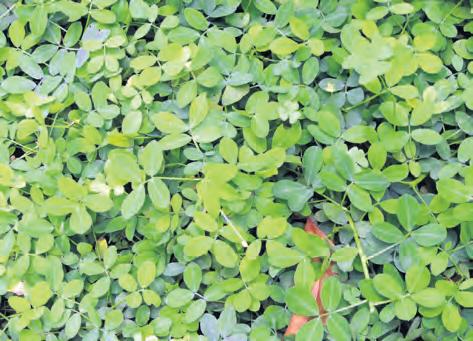
How can I prepare my soil in autumn for spring planting without leaving it bare over winter. In the past I seem to have done more harm than good and consequently have had a slow start to the new growing season.
Maggie Porter Dawlish
Now is the perfect time to boost your soil with green cover crops. Cover crops are plants grown to protect and enrich the soil providing benefits such as reducing erosion, improving soil structure by adding organic matter, managing weeds and pests, and supporting biodiversity by creating habitats for beneficial insects and organisms. They are often grown during winter or a short intercropping period, as they are fairly fast growing with examples which fix nitrogen, scavenge nutrients, or break up compacted soil. In early spring, mow them down and lightly till the biomass into the soil to boost organic matter. Also, add a layer of compost or well-rotted manure in autumn to allow microbial life to incorporate nutrients over winter.

Can I plant trees and shrubs in early autumn. I am out of the country for a few weeks during October. Is it too late when I get back and how do I ensure they establish before winter?
John Clarke Poole
Everything really depends on the weather bring dry and warm but classically autumn is the ideal time to plant trees and shrubs and that can mean anything from mid -September onwards.
November isn’t too late as long as the ground isn’t soaked and is free from frost and still warm.
The best trees and shrubs to plant are native or well-adapted species, dig a hole twice as wide as the root ball, and backfill with native soil (don’t be tempted to use fertiliser at this stage). Water deeply after planting and mulch the root zone, but do not stake unless necessary. Water until the ground freezes to support root establishment.

My Somerset border has struggled this year with the heat and many of the perennials look like they are really finished for the season and deeper into autumn than usual for September. I am conscious more than ever they need boosting for next summer and I need to get out and divide some of them. I am not totally clear which ones will benefit from being divided or how should I do it to ensure survival?
Martin Smith Barnstaple
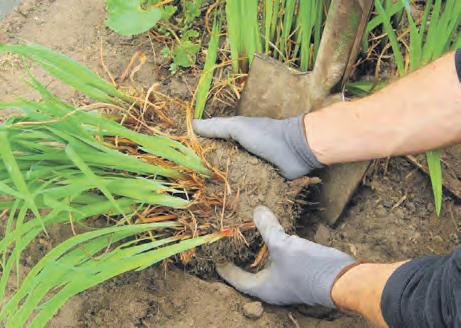
Most perennials are fair game to be divided and yes it should bring them back to more life for next spring. Divide perennials like hostas, daylilies, irises, peonies (early autumn only), and ornamental grasses. Do it when the weather cools but before the ground freezes. Use a sharp spade or garden fork, keep divisions with healthy roots and foliage, and replant at the same depth. Water deeply and mulch to stabilise soil temperatures and retain moisture.
How can I encourage beneficial insect populations through autumn and into the next growing season? I’ve been reading a lot about encouraging insects into my garden and am very keen to have an area which I can re wild.
Sam Holloway Cheltenham
There’s so much you can do, and autumn is a great time to get the project moving.
First of all when you start tidying up the garden leave some spent flower heads and seed stalks as habitat for overwintering insects like ladybugs and native bees. Avoid cutting everything back. Also, consider planting late-blooming natives like asters and goldenrod, which provide crucial nectar and pollen late in the season. Your garden should be extended into early winter in this way and attract more insects.
This spring and summer I have invested a lot of time and effort into my compost bins. I purchased in April a two-part plastic compost bin and have been filling it carefully with greens and browns exactly like the advice suggests. My question is what I should do with my compost pile in autumn to maximize decomposition over winter when the wet and frosts arrive.
Tammy Browne Exeter
The good news is that autumn provides a wealth of brown materials (dried leaves, straw) for composting. It’s a bumper time of the year all round for composting. Go on mixing these with green materials (vegetable scraps, fresh grass clippings, remains from the vegetable harvest, fallen apples and so on) to maintain a healthy carbon-tonitrogen ratio roughly 30 to one. The phrase which seems to be going around amongst gardeners at the moment is to keep the pile moist like a wrung-out sponge, and remember to turn it every few weeks. It is well worth investing in a thermometer to make sure you have the right temperature in your pile. Covering the pile with a tarp can help retain heat and moisture, speeding decomposition.
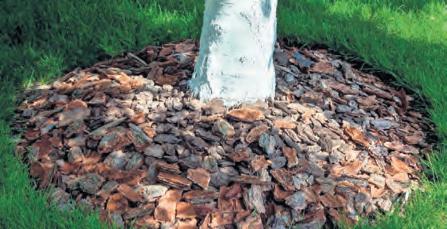
How do I properly mulch trees and shrubs in autumn without promoting rot or pests? My neighbour seems to have a lot of this problem.
Tony Greenway Liss
Mulching is one of the most important jobs of the autumn. You need to apply a two-to-four-inch layer of organic mulch (shredded leaves, straw, or wood chips) around plants, trees and shrubs. The key thing is to keep it a few inches away from plant crowns and stems to prevent rot and pest harbouring. Mulching insulates the soil, prevents freeze-thaw cycles from heaving roots, and maintains soil moisture.
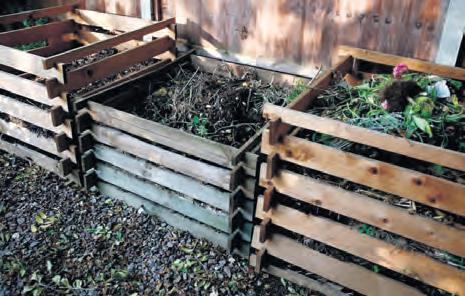
How can I extend my harvest into late autumn without a greenhouse? We have a large open garden which is rather exposed to the westerly winds but often I think we feel the autumn comes rather quickly and ends the season for us early.
Una Stevenson
Containers are one way to make sure your garden extends deeper into the autumn. The advantage is that you can move them out of the wind and bad weather.
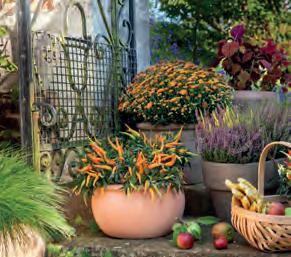
Use row covers, low tunnels, or cold frames over crops like spinach, kale, carrots, leeks, and lettuce. Choose cold-hardy varieties and sow them in late summer for autumn harvesting. Mulching root crops heavily can allow you to store them in-ground into early winter,
What is the best way to overwinter tender perennials or borderline hardy plants? This is our first winter in a new garden and we have bought a lot of plants and shrubs this spring and summer and I am getting worried about Devon getting a hard winter and we could lose a lot of plants.
Lisa Davies Honiton
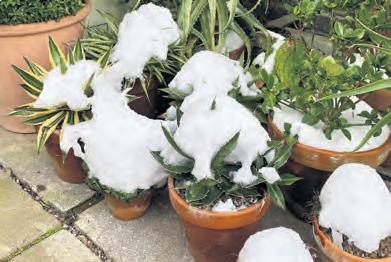
For plants like dahlias, cannas, and tuberous begonias, dig up the tubers after the first frost, let them dry, and store in a cool, dark, frost-free location in dry peat moss or sawdust. For borderline hardy shrubs, use burlap wraps, frost blankets, or windbreaks to prevent desiccation and freeze damage. Make use of sheltered corners in the garden where the frost and cold doesn’t reach and make sure any plants in containers have the benefit of being moved into the shed or garage is the weather really turns bad
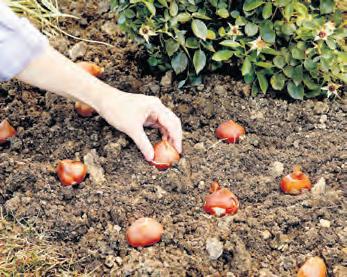
What are the best bulbs to plant in autumn for a spectacular spring display, and how should I plant them? I always look forward to a spring display but mostly end up being disappointed with a poor display?
The answer to this is planning. And of course, you need to invest in buying the bulbs which many garden centres offer in bulk these days. Plant spring-flowering bulbs like tulips, daffodils, hyacinths, crocuses, and alliums in early to mid-autumn when soil temperatures are below 60°F (15°C) and they will thrive in the spring. You will need to plant at a depth of two to three times the bulb’s height, pointed end up. Choose well-draining soil and consider layering different bulbs (lasagna planting) for extended bloom times in containers or beds.
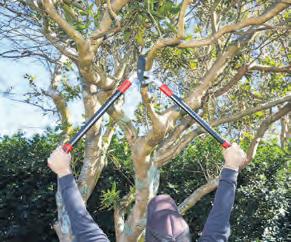

Our popular gardening themed crossword is compiled by Saranda which over the past year has become enormously popular with readers. The winning entry to be drawn by us will receive £100 of RHS gift tokens. Completed entries should be sent to Mount House, Halse, Taunton, Somerset TA4 3AD. Closing date Friday 7th November. The August winner was Anna Shepherd from Minehead.
My fruit trees look rather worse for wear after the summer and early autumn. There’s quite a bit of dead and diseased wood in them. I also didn’t touch them last winter and many of them look rather bedraggled and growing rather haphazardly. I am worried about damaging them even further and affecting the harvest next year. Should I be more diligent with pruning this autumn and when exactly is the right time to do it?
Dave Finch Taunton
It really depends on how damaged your trees are. The general advice would be not to prune too early in autumn as this can stimulate tender new growth that may not harden before frost. What you can do and what sounds important in this case is remove all the dead wood, damaged, or diseased wood only. Taking out the damaged wood should also get some all-important air into the structure of the tree. The serious business of preparing the tree for next year’s fruit should be left for late winter or even early spring when everything is really dormant and pruning will have much more impact.
ACROSS
1. Oven-cooked meat often accompanied by mint sauce (5, 4)
6. A Shakespearean term for a flower such as a buttercup (6-3)
11. Common name of plants of the Euphorbia genus (6)
12. Vegetables of genus Allium (5)
13. Botanically, describing something that has a star-like shape (8)
14. Common name of Zanthoxylum americanum (7, 3)
15. Prunus spinosa or sloe (10)
17. A relish of chopped and pickled vegetables (10)
20. Plants that germinate, flower and die within one season (7)
22. Plan or purpose (4)
23. Famous poem by John Keats (3, 2, 10)
26. An aquatic fern, Marsilea drummondii (6)
28. Nice strawberries? (7)
29. A leisurely walk (6)
30. Indispensable when pruning roses (9, 6)
31. Edible Boletus mushrooms (4)
33. A great enemy (4, 3)
34. Actor who starred in 1989 film, The Rose Garden (5, 5)
36. Made seeds or plants cold to accelerate flowering after planting (10)
37. A decisive battle of the Wars of the Roses in 1471 (10)
40. A citrus hybrid between the sweet and trifoliate orange (8)
42. Common name of Myoporum laetum or mousehole tree (5)
43. Ononis repens or rest-______ (6)
44. The belladonna lily belongs to this genus (9)
45. A parasitic plant that lives on the surface of its host (9)
DOWN
1. More mature and ready for harvesting (5)
2. A starchy root vegetable native to the Andes (9)
3. A type of hybrid flower known for its height and showy flowers (4, 4)
4. Famous Scottish tomato, _____ Craig (5)
5. Sometimes called Kempster's Pippin, this apple was first catalogued in 1818 (8, 6)
6. A sweet winter melon (6)
7. Greek island or variety of lettuce (3)
8. The quality of being too generous (12)
9. Common name of Erica cinerea (4, 7)
10. Highly poisonous plants such as moonflowers (7)
16. Having or appearing to have no stem (11)
18. The official flower of this U.S state is the peony (7)
19. Naples biscuits or okra (4, 7)
21. A biblical meal of lentil stew or something of little value (1, 4, 2, 7)
24. A round, floating leaf of a water lily (4, 3)
25. Cornucopia or goat appendage filled with fruit and flowers (4, 2, 6)
27. A Linnaean class of plants having twelve and sometimes as many as nineteen stamens (11)
31. A creeping moorland shrub with small leaves and black fruit (9)
32. The existence of a tree (8)
33. The national flower of this country was declared in 1986 to be the rose (7)
35. The pheasant's eye belongs to this genus (6)
38. Fruit sometimes called a bilberry (5)
39. French flower! (5)
41. A submerged long-leaved marine plant, Zostera or ___grass (3)














Chloe easy-fit trousers are a Bella di Notte best seller and it’s easy to see why. Crafted from a high quality superflexible fabric, they move with your body for superior fit and style. With a hidden stretch waist and a smooth pocket free finish to create a sleek, sophisticated look.

Ankle width 17cm. Front rise 28cm 76% Viscose, 21% Polyamide, 3% Elastane. Machine washable.

Sizes 8-20. Available in 3 leg lengths. 27” Leg - TR2345, 29” Leg - TR3345, 31” Leg - TR6345.

















































Retired Dorset architect James Tremaine shares what he found to be a thrilling gardening experience of successfully growing a pineapple from a crown cut off a fresh supermarket variety
Most people wouldn’t consider growing a pineapple in the Dorset countryside. But I decided to do just that. It started with a trip to the supermarket in the summer of 2022.
I bought a fresh pineapple for a fruit salad. But when I was trimming it, I paused and looked at the top. It looked alive, you know? Like it could keep growing. I thought, why not give it a go?
Armed with nothing but curiosity and a bit of research on the internet, I set out to grow my own pineapple. I learned that the leafy top—called the crown could be rooted in water and eventually potted in soil. It wasn’t exactly common gardening knowledge, but I loved a good challenge.
I twisted off the crown, peeled away a few of the lower leaves, and let it dry for a couple of days. Then I placed it in a glass of water by the kitchen window. For weeks, nothing much happened. Then one morning, I saw tiny white roots forming. That was it. I was hooked.
I transferred the rooted crown into a pot of well-draining soil and set it in the sunniest spot in the conservatory. By autumn, the plant had taken hold and was growing steadily. But then came the true challenge: surviving the winter.
Pineapples need warmth and humidity—two things the UK isn’t exactly known for so I had to get creative. I built a mini greenhouse within the conservatory using clear plastic sheets, a heat mat, and even a small humidifier I borrowed from my granddaughter.
I monitored the temperature daily, keeping it around 25°C during the day and never letting it drop below 18°C at night. I misted the plant regularly and fed it with a diluted tropical plant fertilizer every couple of weeks.
It became a bit of a project, really a sort of living puzzle. I started keeping a journal of its growth, noting the number of new leaves, the changes in colour, even the exact time of day the plant seemed to perk up. I was surprised how attached I got.
By the following summer, the pineapple plant had nearly doubled in size. It developed long, spiky leaves over two feet long and looked impressively exotic for a plant in rural England. But I still didn’t expect a fruit to grow.
Then, one morning in early July 2024, nearly two years after planting the crown, I noticed a strange growth forming at the centre of the plant.
I honestly thought it was a weed or some sort of fungus at first. But it kept growing, and eventually I realized it was a baby pineapple.
I must admit I was overjoyed. I called the grandchildren over to see it, and they dubbed the little fruit ‘Spiky.’ Over the next several months, Spiky grew to the size of a large orange. Not supermarket-sized but perfectly formed and wonderfully fragrant.
I harvested it in October. The taste oh, it was amazing. Sweeter than any pineapple I’d ever bought. Maybe it was the effort that made it taste better, but it was honestly something special.
Growing a pineapple in the UK may not be the easiest project, and I got lucky with the warm conservatory setup.
It’s not just about the fruit. It’s about learning, watching something grow slowly and steadily, and caring for it through all kinds of weather. There’s something beautiful in that.
I am growing a second pineapple from the top of the one I harvested. And I will go on keeping a journal, hoping to pass it down to one of the grandkids one day.
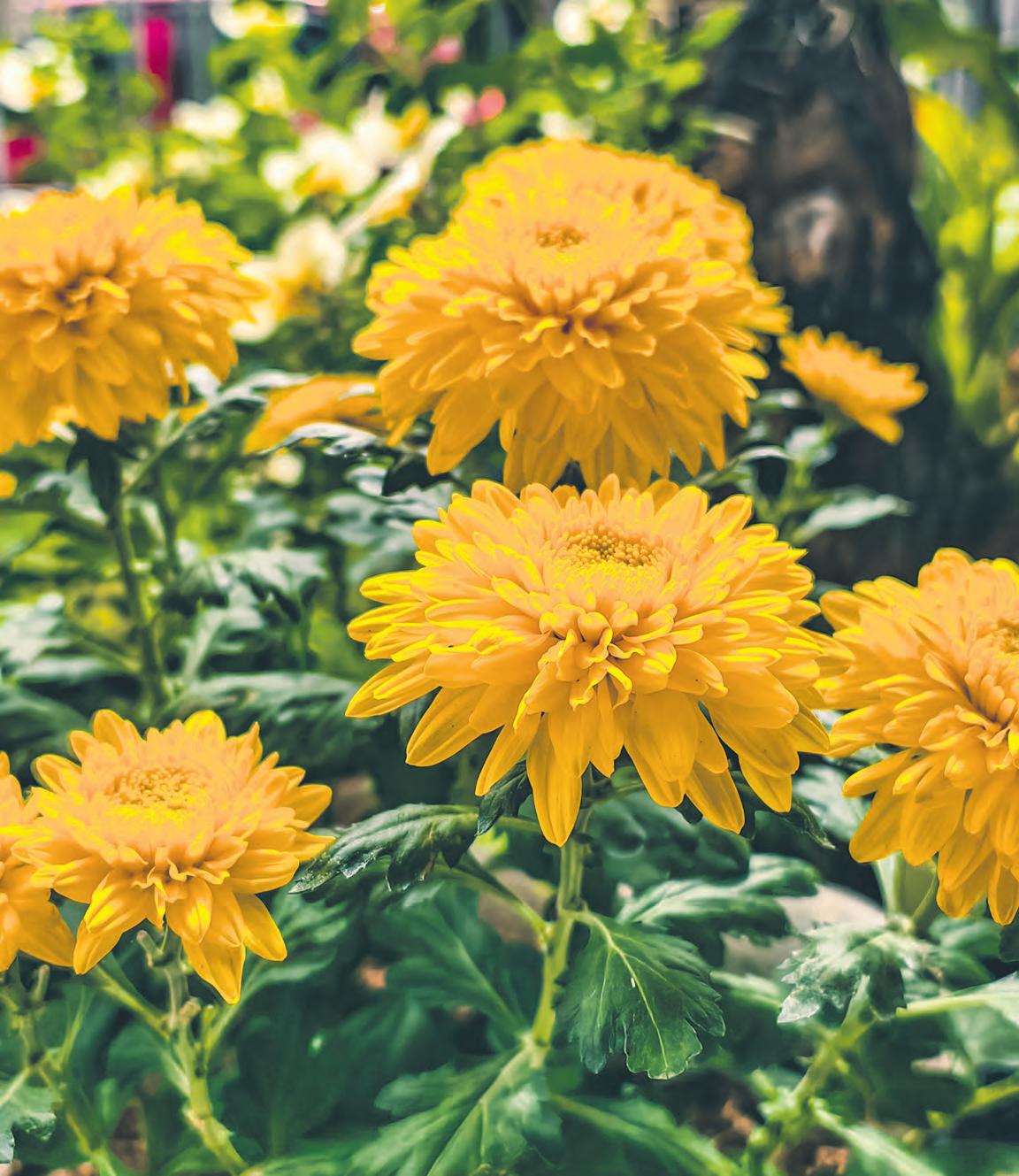
Chrysanthemums are more than just autumn decorations. They are the definitive autumn flowers and able to ‘carry’ gardens, beds, containers, and displays well into the early days of winter.
Chrysanthemums are often thought of as the quintessential autumn flower. Not just because they bloom in autumn, but because they do so long after many other flowering plants have faded. Their blooms persist deep into the cooler months, their colours changing with the light and temperature, so they carry the season forward and sometimes beyond. They always seem to have something new to offer for instance longevity, some newer and bi colour varieties, and specific cultivars to consider for gardens, containers, or cut flower use.
With newer varieties, especially those featuring bi colour petals, coppery or unusual tones, breeders are giving gardeners more artistic options. By choosing hardy varieties, planting well, providing winter protection, and using practices like deadheading and pruning, chrysanthemums can give reliable and long lasting colour, sometimes even beyond autumn into mild winter conditions.
Considered to be one of the most popular flowers in the world, second to roses, of course, chrysanthemums are so much more than a padding flower in a bouquet. This fluffy, vibrant bloom speaks volumes, with special meanings depending on the colour you choose, oh and they’re revered by royalty. We’d say, they’re pretty special.
There are over 150 varieties of this stunning flower to choose from, whether you prefer the bushy, fanned out types or spider blooms featuring spindly petals with curled ends, you’ll find something that speaks to you. With a name that translates literally to gold flower, from the Greek words ‘chryos’ and ‘anthemon’ it’s no wonder this bloom deserves its place in popularity.
The flowers have many different forms, from open daisies to multi-petalled pompoms, large and small. They come in lots of colours and shades, from pink, purple and red, to orange, yellow and white. Chrysanthemums enjoy a warm, sunny, sheltered spot, with fertile, well-drained soil. Water and feed regularly, and protect them from frost.
Most won’t survive heavy frosts or waterlogged soil. They don’t perform well in dry conditions, poor soil or shade.
There are several reasons chrysanthemums are so strongly associated with autumn, and why their popularity endures
They tend to flower when many annuals and summer perennials are past their prime — late summer through autumn. They fill a gap in the garden when warm weather plants fade.

Chrysanthemums hold their flowers for a good long time. Some are hardy perennials (or half hardy) which, if looked after properly, will flower for many weeks, sometimes into early winter, especially in mild climates. Gardeners often use them to keep colour in the bed well after frosts catch the more delicate summer bloomers.
Single daisies, double pompons, cushion types, spider forms, quilled petals, reflexed, incurved, bi colours — chrysanthemums offer an astonishing variety. Their colour palette in autumn is especially rich: golds, oranges, reds, russets, but also surprising whites, greens, purples and bi colour combinations.
Some chrysanthemums are hardy in colder weather; with mulch over winter and good siting, many garden mums survive and bloom year after year. Others, more tender types or pot ‘mums’, may need protection.
So their ability to last beyond autumn depends largely on variety, climate, and good cultural practices (solar exposure, soil, protection from frost etc.).
In recent years, breeders and growers have pushed the boundaries: more bi colour cultivars, richer or more unusual tones (deep purples, near greens, glowing coppers), flowers that combine different colours on reverse / inner / outer petals, etc. Also, newer series (spray mums, disbuds, pot mums) that offer cut flower and container potential. Some trends / notable developments:
• Bi colour and reverse colour petals - Petals that are one hue on the top side and another (often lighter) on the reverse, or with tips different from the base. These give extra visual depth and colour contrast especially as the light fades. For example, ‘Debonair’ which has rosy pink florets and is pale on the reverse.
• Rich autumnal tones and mixed colours. Deep russets, copper, gold, burgundy; colours that echo autumn foliage. Also, cultivars that start one colour and fade into another. The series such as “Flashlight” (pot mums) with combinations like pink/white, red/ yellow etc.
• Hardy garden varieties with improved durability - Garden mums bred for better frost resistance, more compact growth, stronger stems so blooms don’t collapse in wet autumn weather. Also they are more disease resistance. Varieties that, if cared for, come back year after year.
RECOMMENDED VARIETIES
Here are some chrysanthemums that stand out for their colour, bi colour features, longevity, and that are good choices for extending autumn colour. They are grouped by type (hardy garden, pot / spray / cut, bi colour / unusual) to help you select what you want.
C.
2. C.
3. C.
4. C.
5. C. ‘Enbee Wedding’ series
6. ‘Topsy’
pink double flowers, deeper pink centre.
Apricot to deep bronze double pompon flowers. Warm autumnal hues.
Pink purple double blooms; bright colour.
Rosy pink and pale pink on reverse; overlapping, recurved ray florets.
Yellow/pink shades among the series; various colour options.
Rich auburn / coppery flowers with appealing autumn tones.
7. ‘Ruby Raynor’ (AGM) Burnished golden orange double flowers.
8. ‘Imp’
Deep, almost dahlia like blooms in deep crimson.
9. ‘Cream Margaret’ Lemon yellow centre fading to cream tips on petals.
Makes a statement; great for back of borders; fills space with dramatic late bloom.
The bronze tones are perfect for autumn palettes; good garden hardiness.
More compact form; good for front of border or containers; long lasting bloom.
Very pretty for edging; bi colour effects; excellent for mixed displays.
Good for height, back of beds; working in cut flowers; blends well with other warm tones.
Great for bringing warmth; a colour less often seen in mass; dark tones add depth.
Strong, vivid colour; reliable and visually striking.
For those wanting dramatic, rich tones; good for cut flowers.
Very elegant; softer palette; works well with pinks and greens; good in pots.
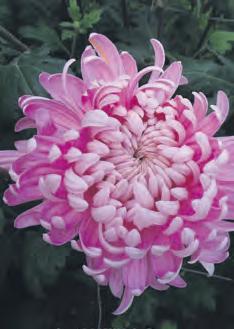
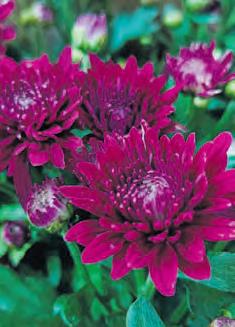
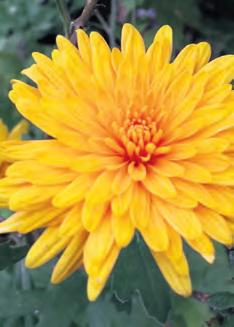
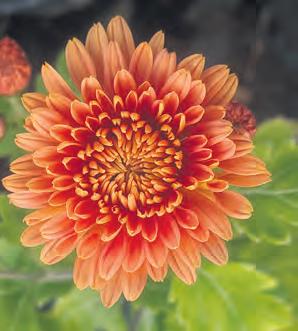





To get chrysanthemums to last beyond their peak season (and ideally over winter or to rebloom), you need to put some specialist knowledge to work.
• Choose hardy garden varieties - Vs tender pot mums, if your garden gets frost or snow. Check the hardiness of the variety.
• Site and soil - Full sun is best (or as much as possible), soil that drains well (chrysanthemums dislike water logging). Mulching helps protect roots.
• Timing and pruning/shaping - Pinching back stems in early summer encourages bushiness and more buds later. Deadheading spent blooms helps prolong flowering. After flowering, cut back stems (but leaving enough structure) before winter. Mulch heavily.
• Protection against frost and wet - Heavy winter rains, frost, snow can damage foliage or weaken plants. Use mulch, protective cloches if needed, or grow in sheltered spots.
• Regular feeding - Fertiliser during the growing season (esp. summer) gives the plant strength; avoid high nitrogen when buds are forming (which can encourage foliage instead of flowers).

Welcome to our Autumn issue of Time Off and details of gardening club and association events over the next few weeks throughout Devon. This is a popular free service and if you would like to take advantage of it and give events some publicity then email them to us at editorial@countrygardener.co.uk
1ST
Brixham Horticultural Society
MONTHLY MEETING
Details on 01803 842121
2ND
Teignmouth Gardening Club
‘GERTRUDE JEKYLL’ - DAVID USHER
email: lenasalter@aol.com
Plympton Gardeners Association
‘A WESTCOUNTRY GIRL OF COLOUR’JACQUIE FELIX
7TH
Marldon Gardening Club
AUTUMN SHOW & ‘INCREDIBLE PERENNIAL VEGETABLES’ - MANDY BARBER
8TH
Goodleigh Horticultural Society
‘WATER, WATER EVERYWHEREABOUT PONDS, BOG GARDENS AND WATERWISE GARDENING’ - REBECCA
FLINTHAM
14TH
Exminster Gardening Club
‘GIANT VEGETABLES’ - CLAIRE HART
Details on 07749 726497
15TH
Holcombe Garden Society
‘FUCHSIAS MY WAY’ - DEREK DEXTER
Details on 01626 862823
Torquay & District Gardening Club
‘HERBS’ - NEIL JONES
email: nickibaker222@gmail.com
16TH
West Down Gardening Club
‘OTTERS’ - STEPHEN POWELL
Details on 01271 865554
27TH
The Clearbrook Horticultural Group AGM & ‘A SEASONAL PLANT REVIEW’ - DAVID MILES
Details on 01752 776230 (evenings)
29TH
Newton St Cyres Gardening Club
‘CACTI & SUCCULENTS’ - ROB VINCENT
Details on 01392 851985
30TH
Exmouth Garden Club
‘HEDGEROW MEDICINE’ - HELEN KEARNEY
www.exmouthgardenclub.co.uk
Budleigh Salterton Garden Club
‘CONSERVATION OF NATIONAL TRUST LIVING COLLECTION OF PLANTS’ - CHRIS TRIMMER
Details on 01395 445840
10TH
The Clearbrook Horticultural Group
‘A GUIDE TO PRUNING IN YOUR GARDEN’ - SAUL WALKER
Details on 01752 776230 (evenings)
24TH
The Clearbrook Horticultural Group ‘THE HEAD GARDENER’S TALK’ - NICK HAWORTH, HEAD GARDENER OF THE GARDEN HOUSE
Details on 01752 776230 (evenings)
8TH
The Clearbrook Horticultural Group ‘CHRISTMAS MAGIC’ - CHRIS FOOTE; DEMONSTRATION AND PRACTICAL ARRANGEMENTS WORKSHOP
Details on 01752 776230 (evenings)
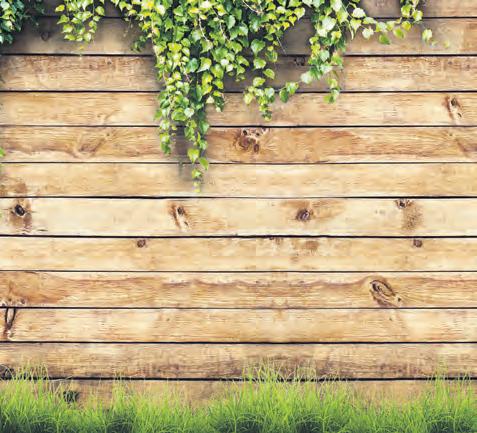


Town and Country Supplies
At our stores we stock: All garden machinery - Mountfield, Husqvarna and Stiga main dealer, plants, shrubs and trees
We also sell: Household products, firewood, coal, bottled gas, clothing and boots We cater for all your pet and farm animal needs - Dogs welcome ONSITE CAFE
For more information, pop in to one of our stores or call: Exeter 01392 811508 Blandford 01258 459455 Bridport 01308 422204 Bere Regis 01929 472328

We look forward to your visit!

Bridford, Nr Exeter EX6 7LB 01647 252654
Traditional Nursery Trees, Shrubs,Climbers and Perennials Hanging Baskets, Patio Plants and Spring Bulbs Garden Shop, Local Produce Competitive Prices
www.teignvalleynursery.co.uk teignvalleynursery@gmail.com

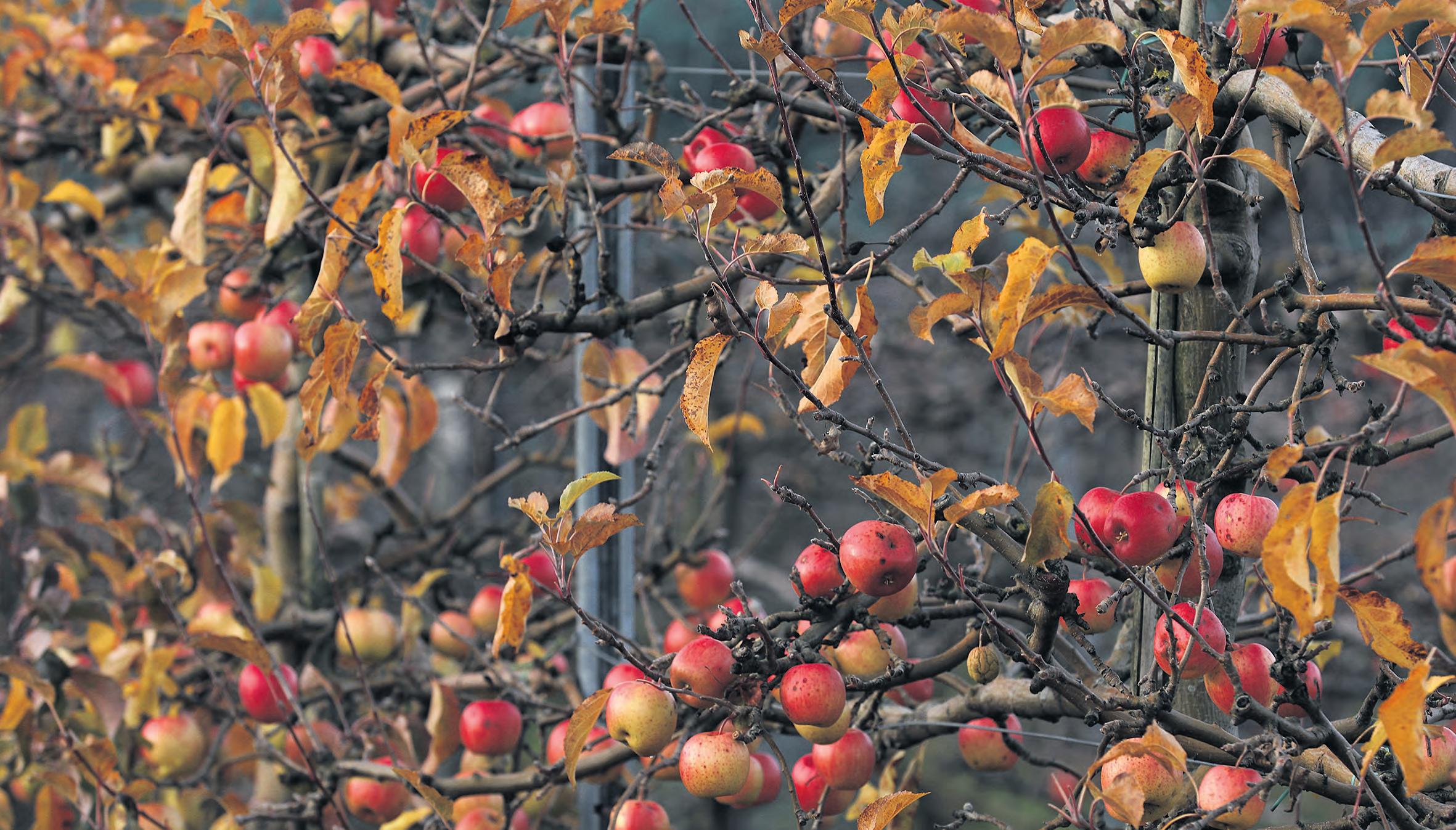
Cider apples are deeply embedded in west country gardens and culinary culture. They offer a distinct range of flavours not typically found in eating apples and for gardeners seeking a rewarding, sustainable, and creative pursuit, planting cider apple trees is a fruitful choice.
Growing cider apples can be highly rewarding for gardeners, combining the pleasures of growing with the satisfaction of producing a unique and valuable crop. Unlike dessert apples, cider apples are grown specifically for their complex balance of sugars, acids, and tannins, which are essential in creating flavourful and wellstructured ciders. Whether gardeners are aiming to make homemade cider or just try something different in their orchard, the benefits of growing cider apples are numerous.
After a decline through much of the 20th century cider apples and artisanal ciders are now experiencing a huge revival. Growing cider apples is very similar to growing dessert apple varieties. They have similar cultural requirements of climate, soils, site selection, nutrition, irrigation and pest and disease control.
The three pillars of quality cider fruit are the varieties used, where they were grown, and the way they were grown. This principal is widely accepted in wine grape growing yet is still a controversial topic in apples.
Apples picked for eating are almost never picked when fully ripe. This is because a major element of the eating apple is it’s crispness. Apples grown for cider should be picked at maximal ripeness. For many varieties, especially the European cider varieties, this means waiting until the apples drop to the ground. For others, this means waiting until the flavour and sugar peaks, a point at which the apple is often soft and reeking of ripe aromas.
Cider apples are categorized into four main types based on their acid and tannin content: sweet, bittersweet, sharp, and bittersharp. This diversity allows gardeners to experiment with different blends, producing a wide variety of ciders with unique taste profiles.
Many heritage cider apple varieties, such as ‘Dabinett’, ‘Kingston Black’, and ‘Yarlington Mill’, are valued for their historical importance and distinctiveness. By growing these apples, gardeners help preserve rare cultivars that are increasingly at risk due to commercial farming’s focus on a narrow range of eating apples.
Cider apple trees are generally more resilient and require less maintenance than many modern dessert apple cultivars. Many traditional cider apple varieties are well adapted to local climates and soil conditions, and are often more tolerant of pests and diseases. This resilience reduces the need for chemical treatments, making them ideal for organic or low-intervention gardening.
Once established, cider apple trees can thrive with basic care, offering high yields year after year. Younger producers are reintroducing heritage techniques such as
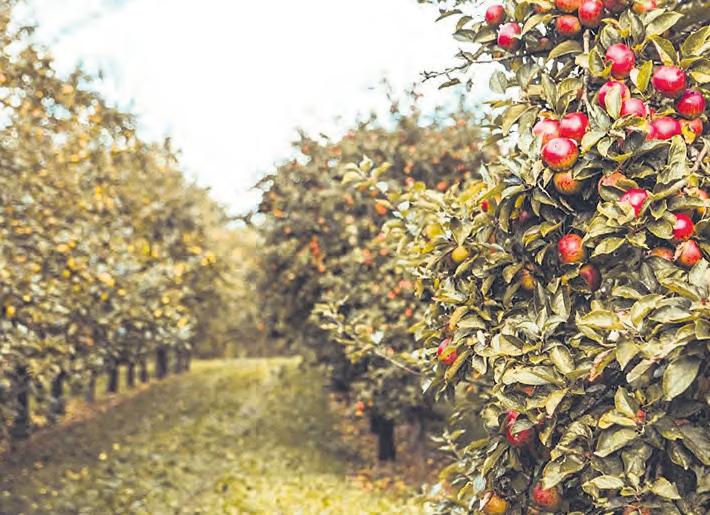
the champagne method, keeving, and “pet nat” to craft fine ciders—a trend that’s elevating cider’s image and pricing it alongside wine Concurrently, genetic preservation projects—like those led by the University of Bristol and Sandford Orchards—are working to rediscover and conserve rare, lost cultivars with resilience to pests and climate change.
For many gardeners, the most exciting benefit is the opportunity to make their own cider. Home cider-making is a relatively simple process and can be tailored to suit personal tastes. By growing their own cider apples, gardeners can control every aspect of production—from cultivation to fermentation. This not only promotes selfsufficiency but also provides a deeper connection to the food and drink they consume. Homemade cider can also be shared or gifted, adding a personal touch to social gatherings and celebrations.
Beyond personal use, growing cider apples can offer small-scale economic opportunities. With the resurgence of interest in craft cider, there is increasing demand for high-quality cider apples among local cidermakers and community orchards. Gardeners with surplus fruit can sell or trade apples, or even collaborate with local producers. Some may even venture into their own small-scale cider business. Community apple presses and festivals also provide opportunities to connect with other growers and enthusiasts, fostering community spirit and shared knowledge. Cider apple trees contribute positively to local biodiversity.
The trees themselves provide habitat and food for birds, insects, and pollinators.
Many traditional orchards are rich ecosystems that support a wide range of flora and fauna. Additionally, growing diverse apple varieties helps maintain genetic diversity, which is crucial for the long-term resilience of apple crops in the face of climate change and evolving pests.
Many cider apples flower late, and not all are self-fertile.
Mixing bittersharps, bittersweets, and sharps ensures good cross-pollination and balanced juice profiles.
Expect two to three kilos of apples to produce one litre of juice—ciders require substantial yields Harvest times vary: early cultivars like Frederick ripen mid October, whereas others like ‘Yarlington Mill’ or ‘Dabinett’ may hang until November.
Cider apples are grouped by tannin and acidity:
• Bittersharp (high tannin, high acid): ‘Kingston Black’, ‘Dymock Red’, ‘Foxwhelp’.
• Bittersweet (high tannin, low acid): ‘Dabinett’, ‘Yarlington Mill’, ‘Harry Masters Jersey’.
• Sharp (low tannin, high acid): ‘Bramley’, ‘Grenadier’, ‘Tom Putt’.
• Sweet (low both): ‘Morgan Sweet’, ‘Ashmead’s Kernel’.
• ‘Dabinett’: Highly popular bittersweet. Reliable, often self-fertile, and excellent for single-varietal cider.
• ‘Kingston Black’: Esteemed bittersharp, lauded as near “perfect” for cider but prone to disease and biennial fruiting.
• ‘Foxwhelp’/’Red Foxwhelp’: Historic bittersharp; powerful juice, often used for blending.
• ‘Crimson King’: Sharp with high acidity, heavy cropping, suited to blending.
• ‘Yarlington Mill’, ‘Major’, ‘Harry Masters Jersey’, ‘Ashton Brown Jersey’: Other stalwart bittersweets offering yield, tannin, or compact growth habits.
Numerous heritage and modern varieties—such as ‘Tremlett’s Bitter’, ‘Michelin’, ‘Morgan Sweet’, ‘Porter’s Perfection’— are available for blending or niche production. As of 2011, the UK was cultivating over 365 named cider apple varieties, with over two million new trees planted in preceding years.
Key threats to the health of cider apple include:
• APPLE SCAB: Affects fruit and foliage—common in varieties like ‘Crimson King’ and ‘Kingston Black’.
• CANKER: Impacts twigs and young wood.
• FIRE BLIGHT: Especially problematic for varieties like ‘Brown Snout’.
• MILDEW: Can affect leaves and soft shoots. Select varieties known for resistance to regional diseases—e.g. ‘Yarlington Mill’ resists mildew and canker, ‘Dufflin’ resists scab.
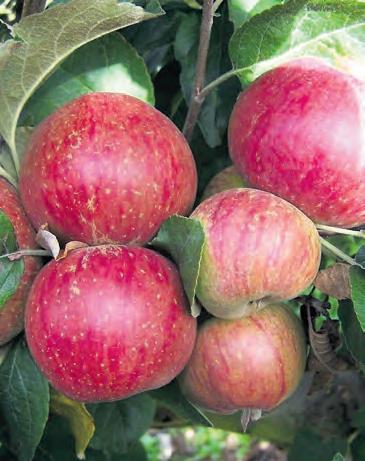
Some of the earliest documented cider apples trace back centuries.
For example, ‘Foxwhelp’, a bittersharp cultivar prized for its potent cider, was referenced in 1664 by John Evelyn and commanded high prices by the early 18th century.
Similarly, ‘Kingston Black’, originating in Somerset,rose to prominence in the early 19th century as a premier vintage cider apple. By the mid-20th century, it was noted by research authorities as “more widely grown than any other cider apple” in west England. Industrial cider-making in the mid-1900s favoured concentratebased production, diminishing the cultivation of traditional apple varieties. But in recent years, a resurgence of interest—led by boutique cider producers and heritage conservationists—has sparked renewed planting and blending of classic varieties, often for high-end markets.


How long does it take to grow a cider apple tree?
An apple tree typically takes seven to ten years to grow from seed to fruit-bearing maturity. However, if you start with a grafted tree sapling, it can begin to produce fruit in four years. With a dwarfing rootstock, varieties may bear fruit even sooner, often within three years.
How many apples does it take to make one litre of cider?
If you do have your own apple tree, a good tactic is to place a sheet under the tree and then shake the tree onto the sheet, this will ensure only the ripe apples fall from the tree. You’ll need approximately two kg of apples for every one litre of cider you want to produce.
What apples are used for cider in the UK?
‘Dabinett’ is the premier traditional English cider apple variety and produces a bittersweet juice. No home cider orchard should be without it. It is one of the few cider apples that can be used on its own, to make a ‘single varietal’ cider - most ciders are blended using different varieties.
What are the common cider making mistakes?
Volatile acidity, oxidative damage, and sulfur off-odors are three of the most common cider sensory deviations (faults) that can arise during production.
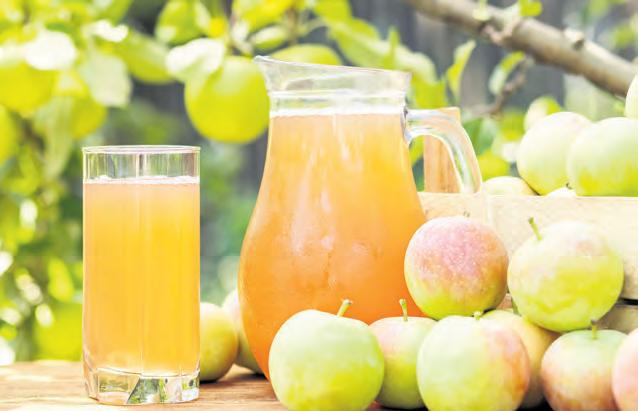
Is homemade cider shelf stable?
• Cider apples are enjoying a renaissance—driven by fine cider makers, heritage conservation, and renewed consumer interest.
• From 17th-century favourites like ‘Foxwhelp’ and ‘Kingston Black’ to midcentury declines and modern revival, cider history in the UK is rich and cyclical.
• Traditional spread orchards are giving way to semi-vigorous systems, with careful choice of rootstocks, pollination partners, and harvest planning.
• Varieties: Balance is achieved by blending bitter, tannic, sharp, and sweet types. Standouts like ‘Dabinett’ and ‘Kingston Black’ can yield characterful singlevarietal ciders.
• Uses: Modern techniques and culinary fusion are reshaping cider, making it competitive with wine, both as a drink and a craft product.
While hard cider can be aged for years, it becomes drier as time passes, and the general shelf-life of cider is a year or two. Cider will last but the danger is it will turn to vinegar if left too long.
How long before you can drink homemade cider?
In fact, a cider “brew day” could be as short as adding yeast to juice. Turnaround is quick too; you could be drinking your homemade cider in two or three weeks
Can you freeze apple cider?
Absolutely! Freezing apple cider is a simple and effective way to keep that delicious, fresh taste on hand year-round. No need for fancy equipment, and you can use a variety of containers to suit whatever amount you have left over.
ACCOMMODATION
Secluded cosy cabins & lodges in wooded valley running down to Wembury Bay & SW Coastal Path

Plymouth, Dartmoor & lovely South Devon Villages & Towns in easy reach. Pets Welcome. Forest School. Tel: 01752 862382 www.churchwoodvalley.com

Carmarthen Bay South Wales Seafront chalet situated on estuary. Sleeps up to 6. Seaview. Well Behaved Dogs Welcome Free of Charge. Free WIFI. Open from 1st March - 31st Dec. For Brochure Tel: 01269 862191
BOSWORLAS, ST JUST. Cosy Cottage sleeps 2-4. Please email info@bosworlas.co.uk for availability
GLORIOUS NORTH DEVON. Only 9 cosy caravans on peaceful farm. Wonderful walks in woods & meadows. Easy reach sea, moors & lovely days out. £125-395pw. Discount couples. Nice pets welcome. 01769 540366 www.snapdown.co.uk
ACCOMMODATION HOLIDAY COTTAGES
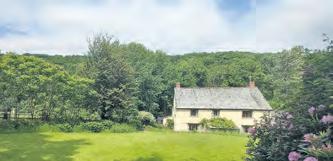
NORTH DEVON NEAR CLOVELLY. 3 delightful cottages situated in 12 acres of idyllic countryside. Sleeps 2-4. 1 Wheelchair friendly. Brochure: 01237 431324 www.foxwoodlodge.co.uk foxwoodlodge@outlook.com


Yenstone Walling Dry Stone Walling and Landscaping Patrick Houchen - DSWA member Tel: 07751278363 / 01963371123 www.yenstonewalling.co.uk
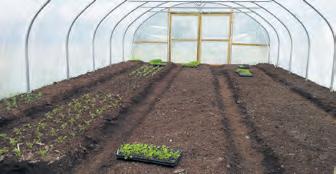
POLYTUNNELS
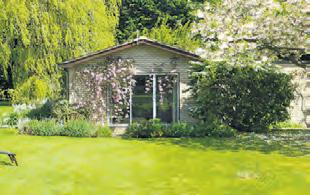
Near Stratford-upon-Avon
Lovely self-catering cottage in peaceful location: large garden. Sleeps 2. Perfect for famous gardens, NT properties & Cotswolds. Tel: 01789 740360 www.romanacres.com

WYE VALLEY/FOREST OF DEAN. Fully equipped single-storey cottage with two en-suite bedrooms. Wi-fi.Recently awarded Visit England 4-star GOLD. Rural retreat, shops/pubs one mile. Enquiries welcome. AS SEEN ON ESCAPE TO THE COUNTRY! Tel: 01594 833259 www.cowshedcottage.co.uk

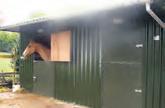
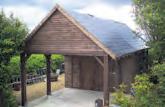
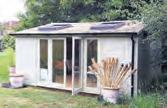

range of over 200 greetings cards and prints from the flower paintings of ANNE COTTERILL
We sell to both individuals and trade. No order too small. Contact us for your free catalogue.
Mill House Fine Art Publishing, Bellflower Gallery, Market Place, Colyton, Devon EX24 6JS Tel. 01297 553100 info@millhousefineart.com www.millhousefineart.com

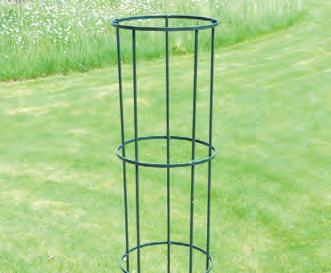




For anyone who has ever bought a houseplant, shrub or tree for the garden with the best intentions, only to watch it wilt, yellow, and collapse into compost, the question is all too familiar: W hy do plants die?
It’s easy to assume that some people just aren’t born to garden. But the truth is, plant death in its many forms usually has less to do with some innate gift and more to do with understanding basic plant needs—and how often those needs go unmet.
Here’s a look into the most common reasons plants die, and how a little knowledge can turn your indoor jungle or garden patch into a thriving oasis.
Perhaps the most frequent cause of plant death is improper watering. While many assume plants just need “a good soak now and then,” the reality is that different plants have different hydration needs.
Overwatering is especially notorious. When soil stays soggy, roots can’t access oxygen, leading to root rot a fatal fungal condition. The signs can be misleading, too. Yellowing leaves might suggest dryness, prompting more water and worsening the problem.
On the other hand, underwatering leads to dehydration, wilting, and a drop in photosynthesis. Some plants bounce back after a drought, but others never recover.
SOLUTION: Learn your plant’s water preferences and stick a finger into the soil before watering. If the top inch is dry, it may be time to water but just don’t water without some sort of test.
Sunlight is life—or death—for a plant. One of the most overlooked killers of plants, especially indoors, is inadequate or excessive light.
SOLUTION: Match plant types to your home’s natural lighting, and don’t hesitate to rotate or relocate them as the seasons change. Outdoors check what your plant needs to thrive.
Plants rely on soil not just for anchorage but for nutrients. Poor-quality soil, often dense, dry, or lacking organic material, can suffocate roots or starve plants of what they need to grow.
Over time, nutrients in potting soil deplete. Without regular replenishment through fertilisers or repotting, plants may show signs like stunted growth, leaf discoloration, or dropping leaves.
SOLUTION: Use the right soil mix (e.g., cactus mix for succulents, peat-based mix for ferns) and feed your plants every few weeks during the growing season.
Plants, like people, have temperature preferences. A sudden cold snap, a heater blasting nearby, or a drafty window can shock or kill a plant quickly.
Tropical houseplants, especially, hate cold drafts and dry air. Leaves may curl, turn brown, or drop off entirely after exposure to extreme conditions.
SOLUTION: Keep plants in stable environments, away from radiators, air conditioners, or open windows. In winter, mist plants to increase humidity or group them together to create a microclimate.
A plant that’s been in the same pot for years may become root-bound, meaning its roots circle the inside of the pot with nowhere to grow. This can choke the plant and lead to nutrient deficiency and water imbalance.
If your plant is growing slowly despite good care, or you see roots poking out of the drainage holes, it may be time to give it more space.
SOLUTION: Repot every twelve months into a container two inches larger in diameter, refreshing the soil as you go.
Ironically, plants can die from both too much attention and not enough. Some people dote on their green friends daily, watering obsessively and moving them around constantly. Others forget their existence for weeks. Plants thrive on consistency. Wild changes in their environment, schedule, or care routine can create stress and decline.
SOLUTION: Establish a plant-care routine that suits both you and your plants. Sometimes, doing a little less is doing more.
Ultimately, the most fatal mistake may be choosing the wrong plant for your space or lifestyle. A basil plant in winter by a frosty window for example will be short-lived. Many plant deaths could be avoided simply by choosing specimens that match your space, lighting, and care capabilities.

A succulent placed in a dark corner will grow leggy, pale, and eventually perish. Likewise, a shade-loving
Sometimes, it’s not what you’re doing—but what’s doing your plant in. Pests like spider mites, aphids, mealybugs,
SOLUTION: Be honest with yourself. If you travel often, go for hardy options like ZZ plants or snake


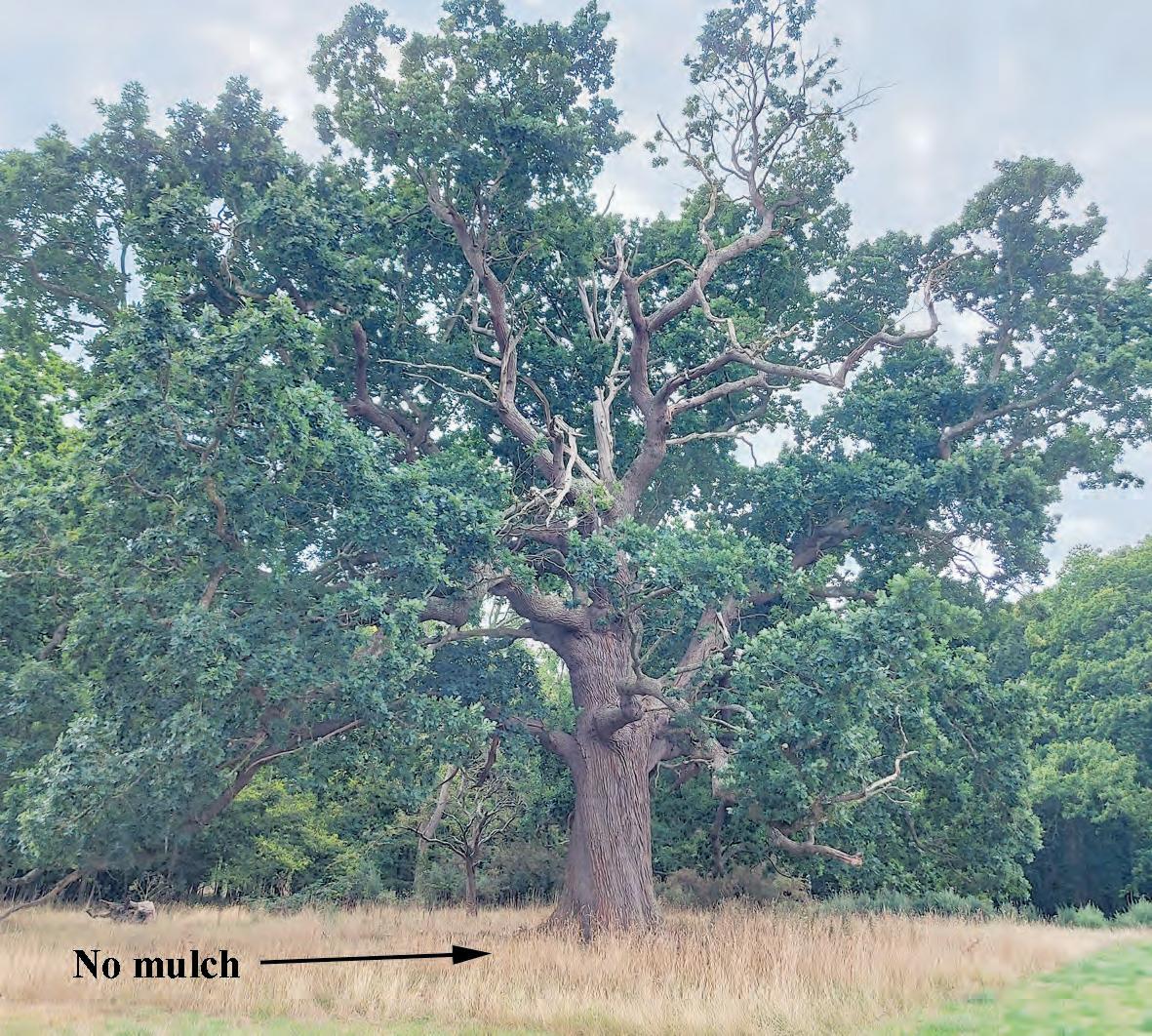
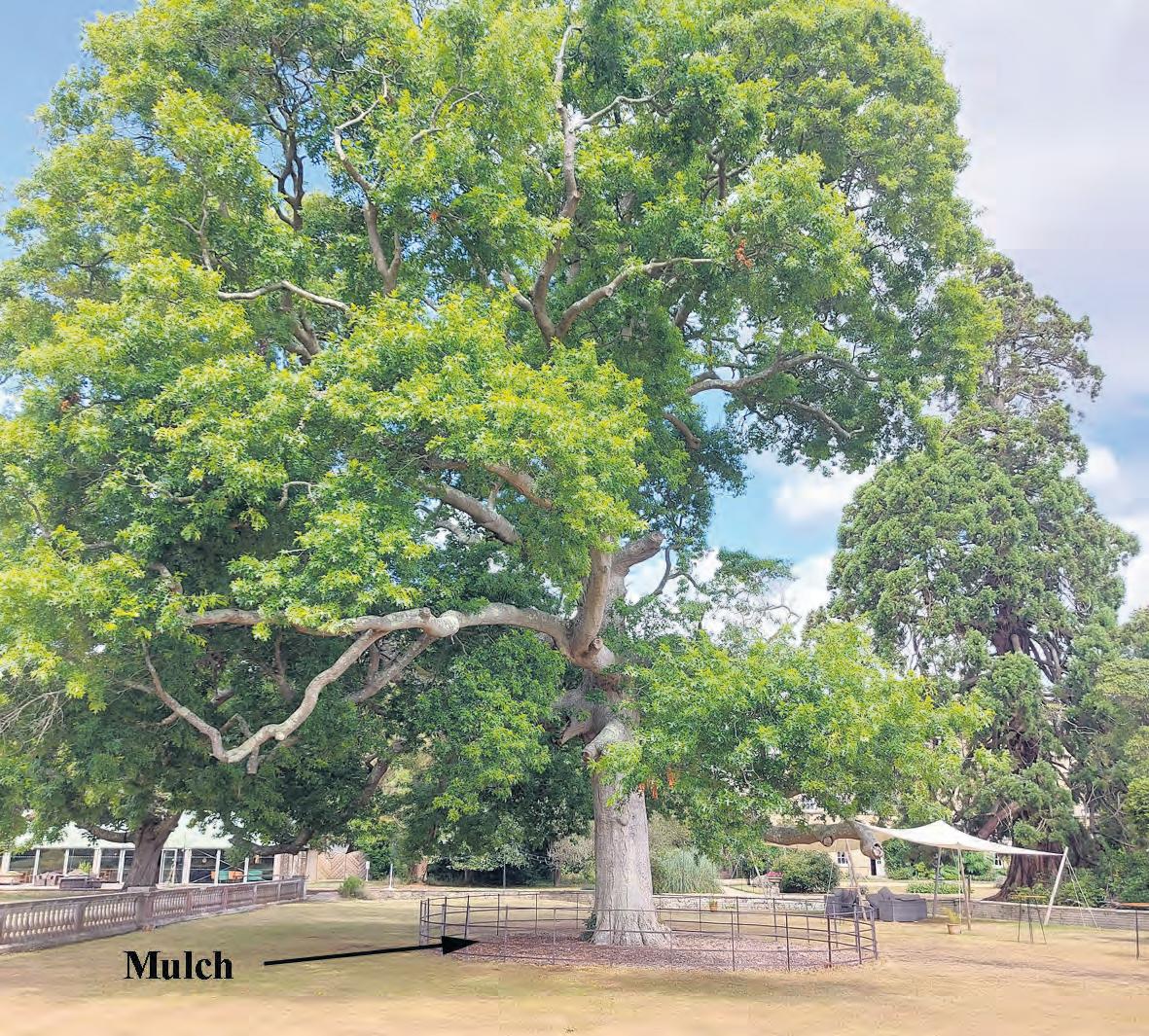
Mark Hinsley explains that 100mm depth of composted woodchip around the base a tree will give any tree back that woodland soil it needs to withstand drought.
Picture the floor of a woodland.
You will see a layer of last year’s fallen leaves mixed with twigs, seed cases and other debris from the trees above. Beneath this layer is the previous year’s fall much broken down into stringy compost and below that a deep layer of humus (Only one ‘m’ – don’t try to spread it on a pita bread!).
Delve down a few inches and you will find the forest soil – a brown earth enriched with the nutrients and organic matter from the humus layer above. Throw in some dead insects and earthworms to up the nitrogen content and you have the perfect feeding and protecting blanket for the healthy growth of tree roots.
When it rains the water comes through the tree canopy dripping gently onto the ground for long after the rain has stopped, soaking in, not washing away. Like a giant sponge the fibrous material in the soil holds the moisture whilst the shade from the trees and the top layer of leaf litter protect the ground below from the heat of the sun and stop the water evaporating away.
Gradually the water is released from the sponge, making it available to the tree roots long after the last time it rained. The roots live protected from the extremes of heat and drought in the summer and lashing rain, floods and frosts in the winter by their giant natural comfort blanket.
For millions of years forest trees in temperate climates lived like this. They survived ice ages, meteorites, dinosaurs, hot periods, volcanic periods, earthquakes and the movement of the continents around the planet. They thought they were invincible! Until one day, the greatest threat to trees of them all comes rolling across the horizon with a sketch pad and a pencil in their hand. Oh No! Its……. the’ Landscape Gardener’…. and what does the ‘Landscape Gardener’ bring with them? For Superman it was kryptonite – for trees it is grass.
Editorial Publisher & Editor: Alan Lewis
alan@countrygardener.co.uk
Tel: 01823 431767
Time Off
Kate Lewis
editorial@countrygardener.co.uk
Advertising Sales
Suddenly the deep, warm, moist comforting woodland blanket has gone to be replaced with acres of parkland grass. All that lovely leaf mould raked away because the grass cannot cope with it. Grass does not care about moisture retention; if there is a drought it just goes brown and pretends to die letting the rays of the sun heat the soil and evaporate any moisture that might be left after the grass has had first go at it.
Grass does not like shade – so its slavish servants cut the low branches off the trees to let the heat reach the ground. When the leaves fall its acolytes rake them up and take them away because the grass does not like them. Rainfall bounces off the hard ground and runs away – there is no woodland sponge to hold it.
At the end of the drought all it takes are a few drops of rainwater and, like Dracula rising from his coffin, the grass is back sucking the life out of everything once again.
“How can we save our trees from this evil?”, I hear you cry! Well, for the arboricultural Van Helsings among you – there is a wooden stake that can be figuratively thrust through the evil heart of the grass, and it is called – mulch.
Laying 100mm settled depth of composted woodchip for as wide a circle around the base of the tree as you can, minimum one metre radius up to canopy edge, will give the tree back that woodland soil that it needs to withstand drought.
The trees have coped with climate change before, but they need their woodland soil to do it.
Mark Hinsley, of Mark Hinsley Arboricultural Consultants Ltd, offering tree consultancy services. www.treeadvice.info
Ava Bench - Somerset & Hampshire
ava@countrygardener.co.uk
Tel: 01278 786139
Corina Reay - Cotswolds, Devon & Dorset
corina@countrygardener.co.uk Tel: 01823 410098
Classifieds classified@countrygardener.co.uk
Accounts and subscriptions
Heather Rose heather@countrygardener.co.uk
Design & Production
Aidan Gill
aidan@countrygardener.co.uk
Gemma Stringer
gemma@countrygardener.co.uk
Distribution & Stockists distribution@countrygardener.co.uk














